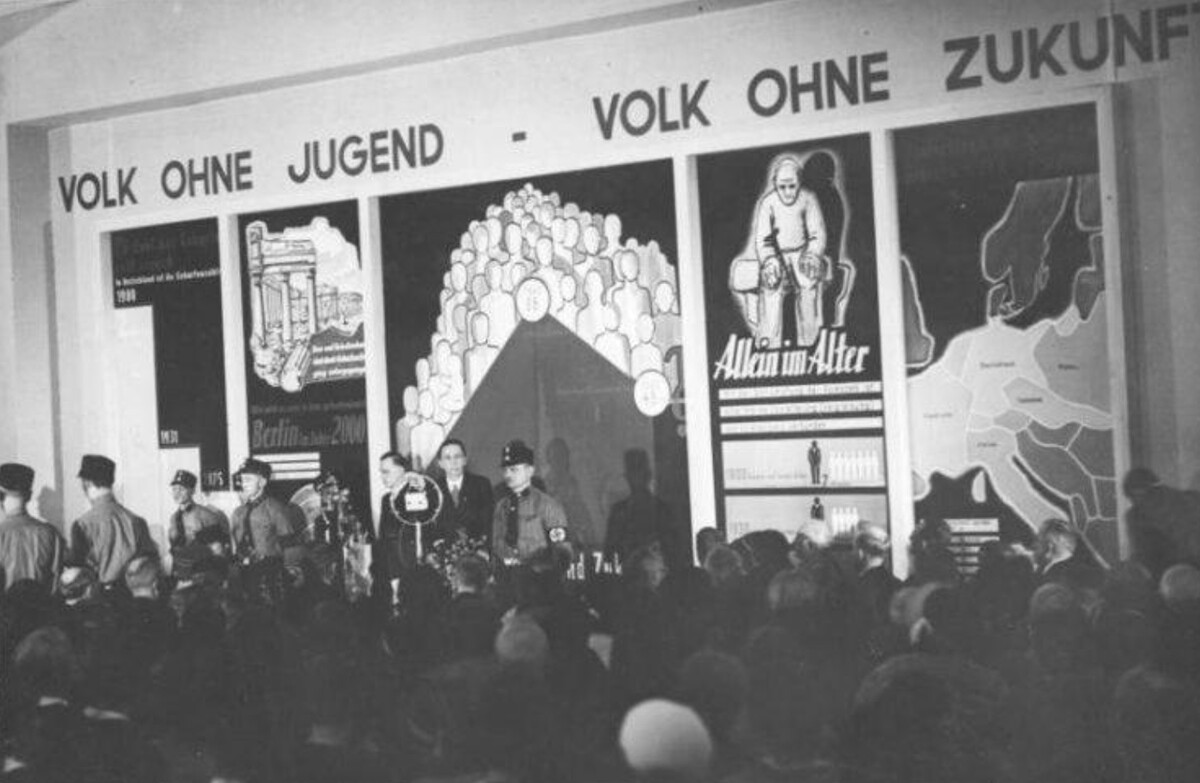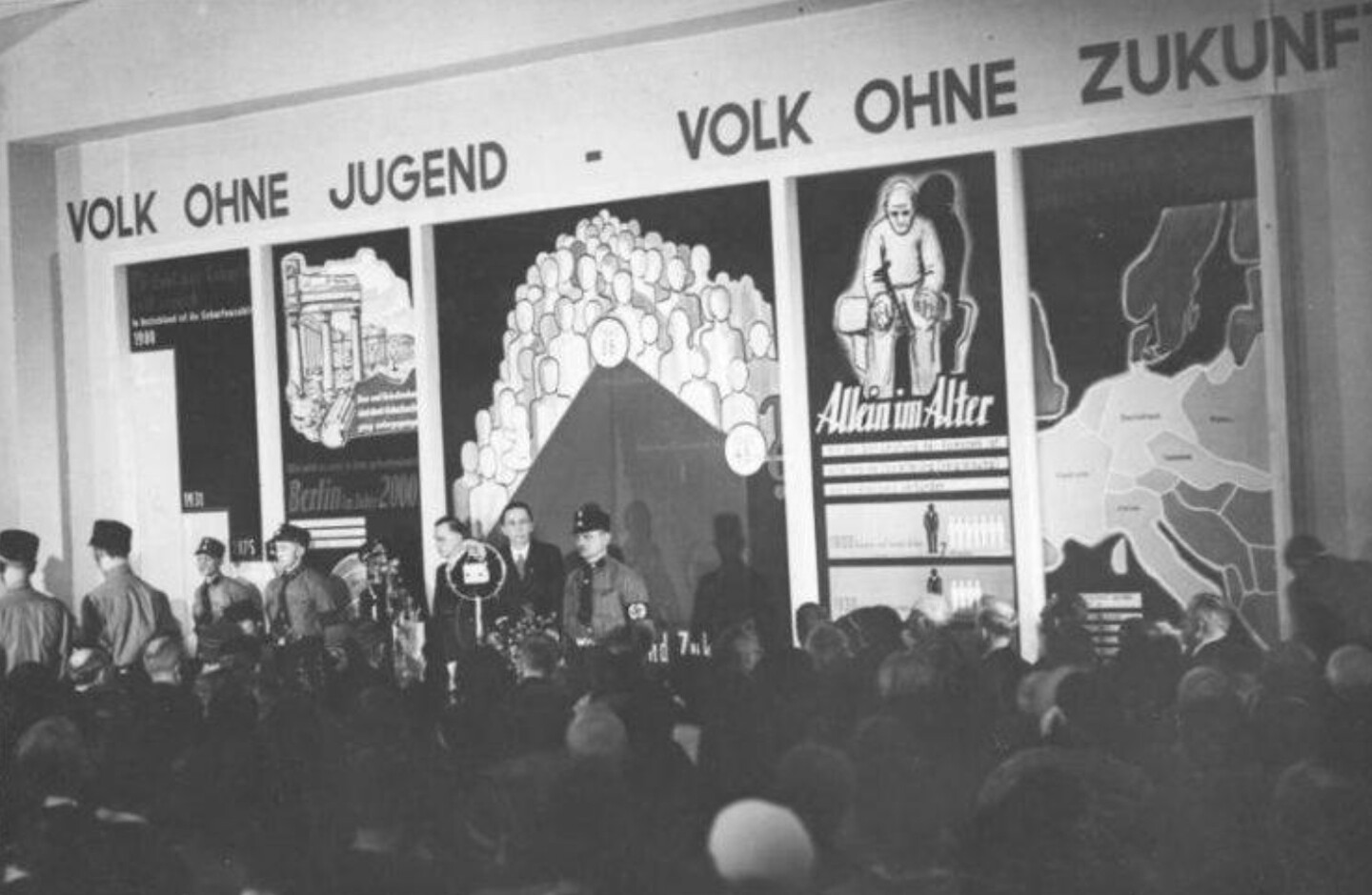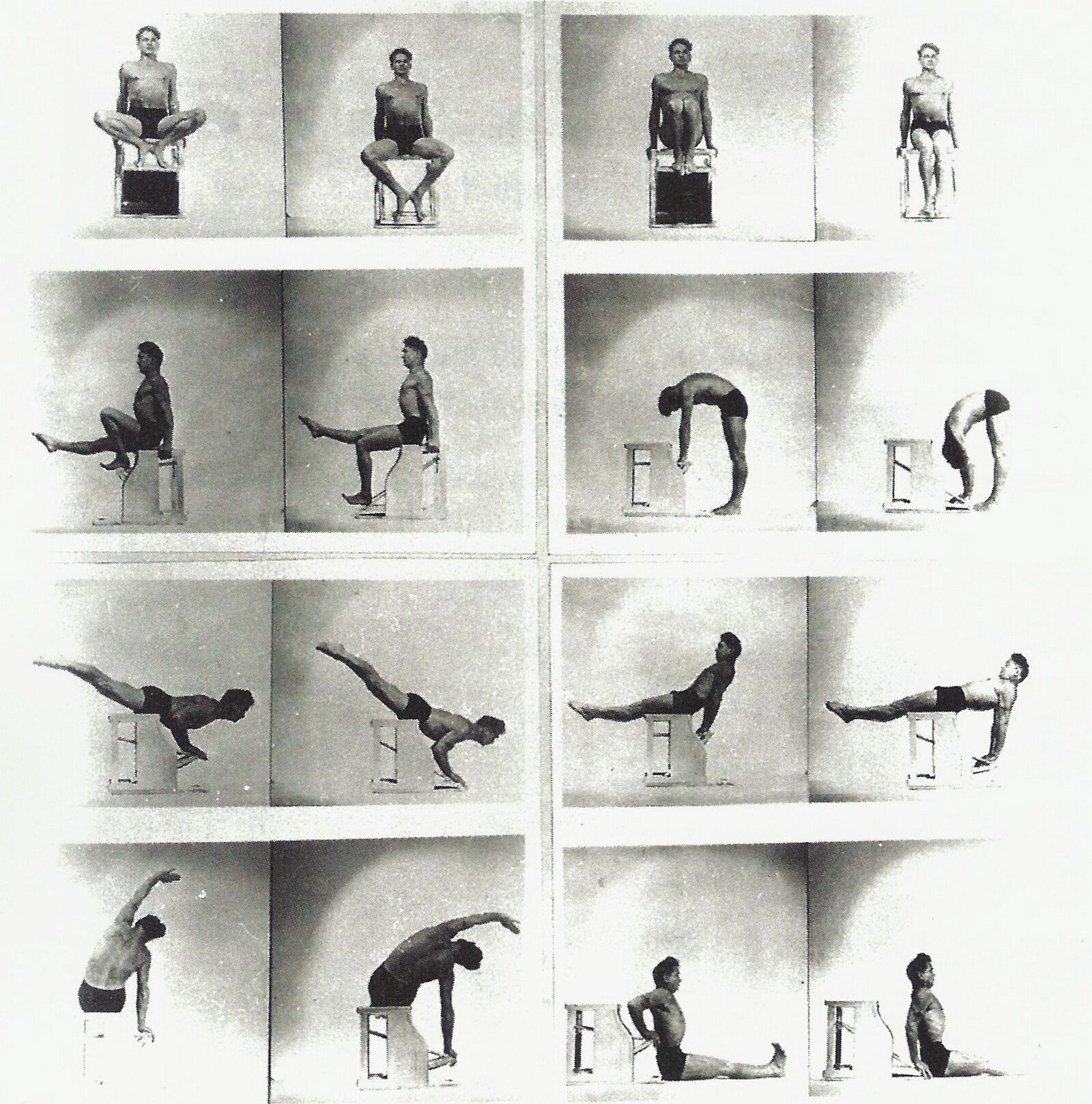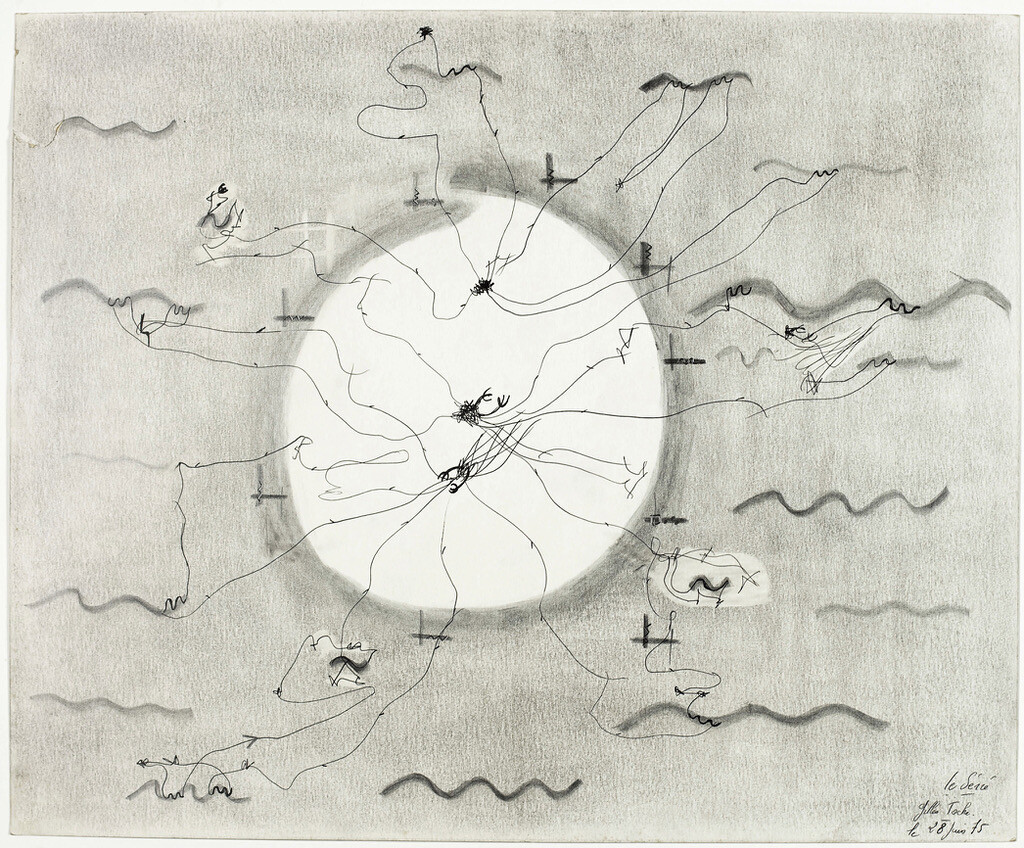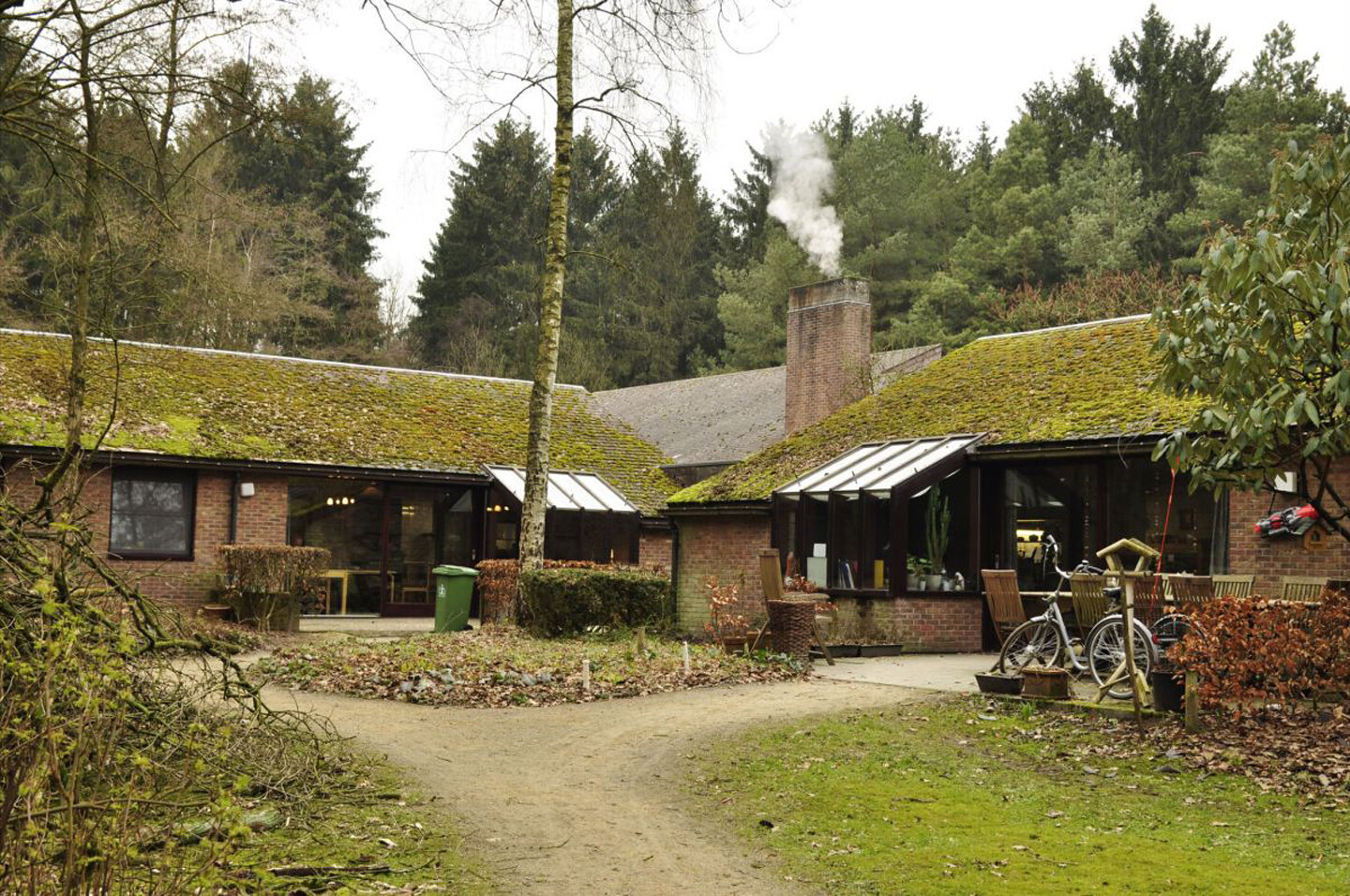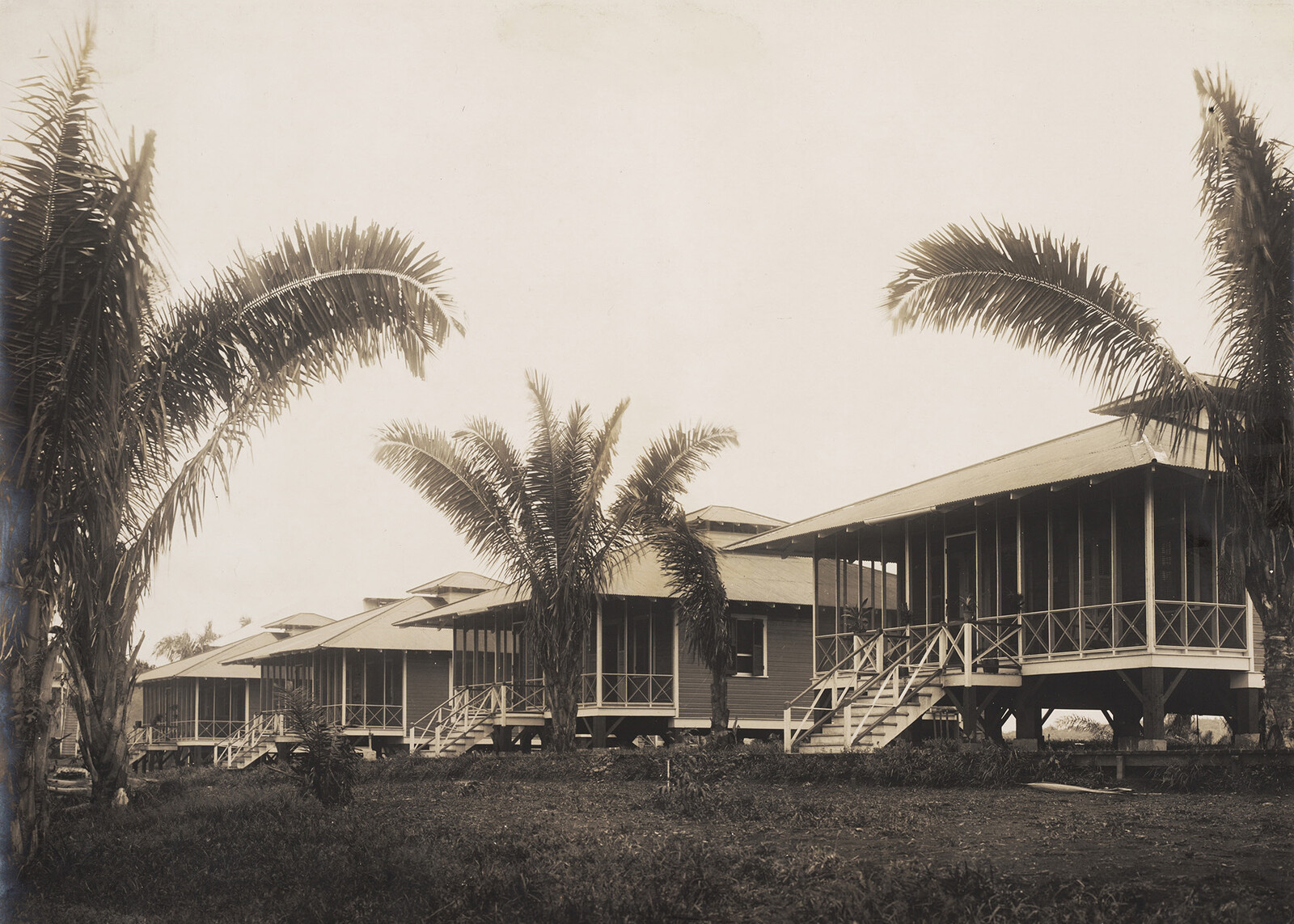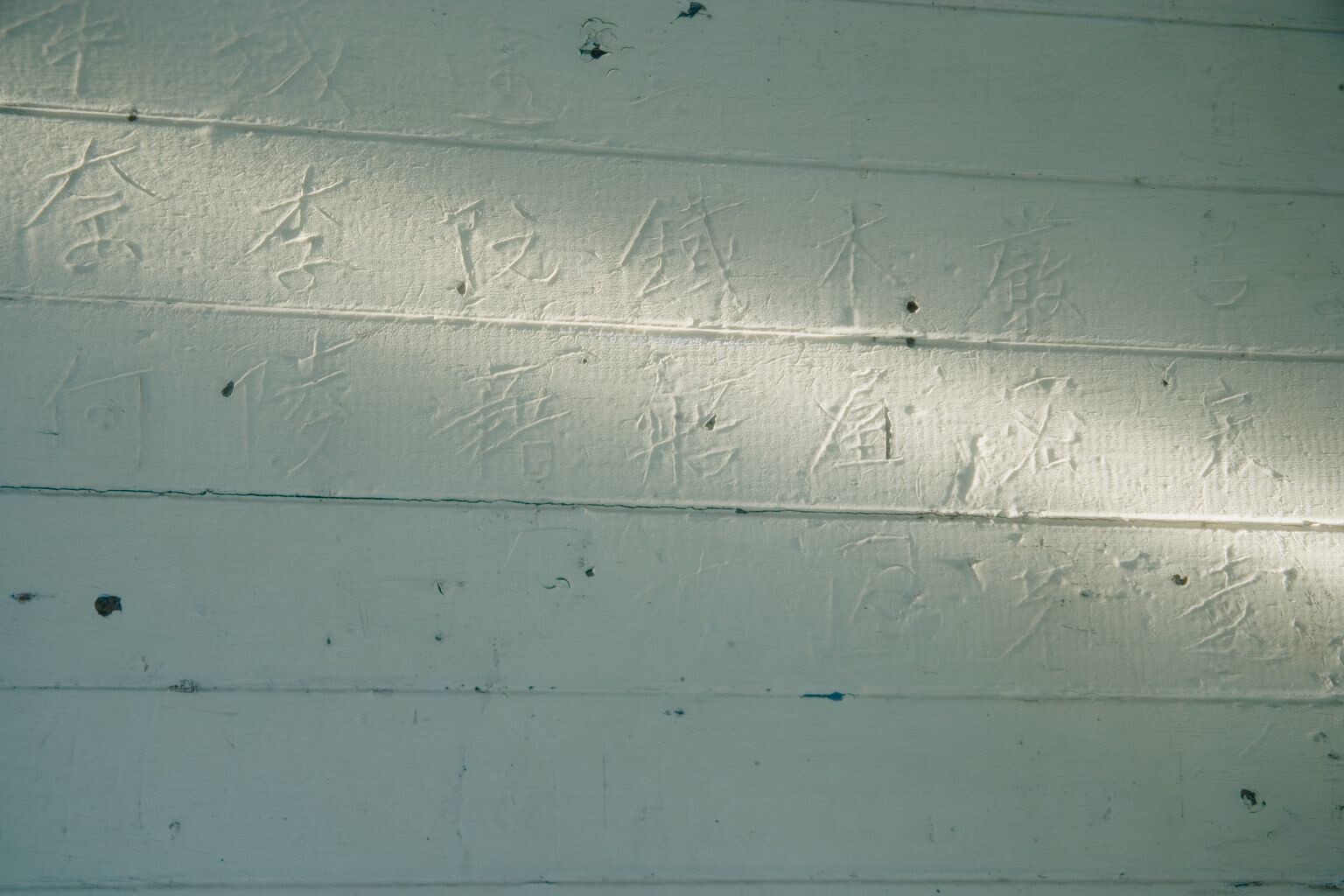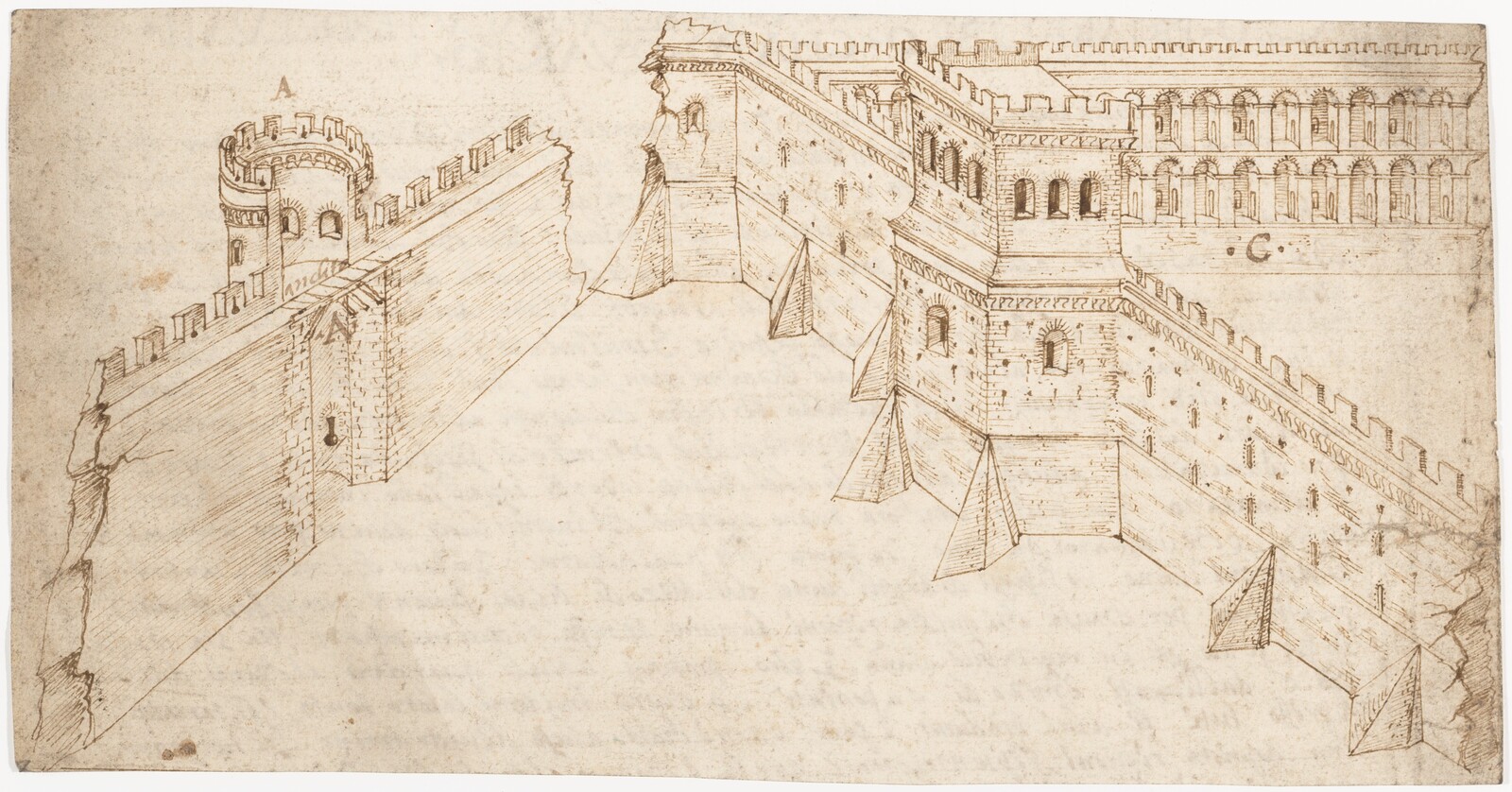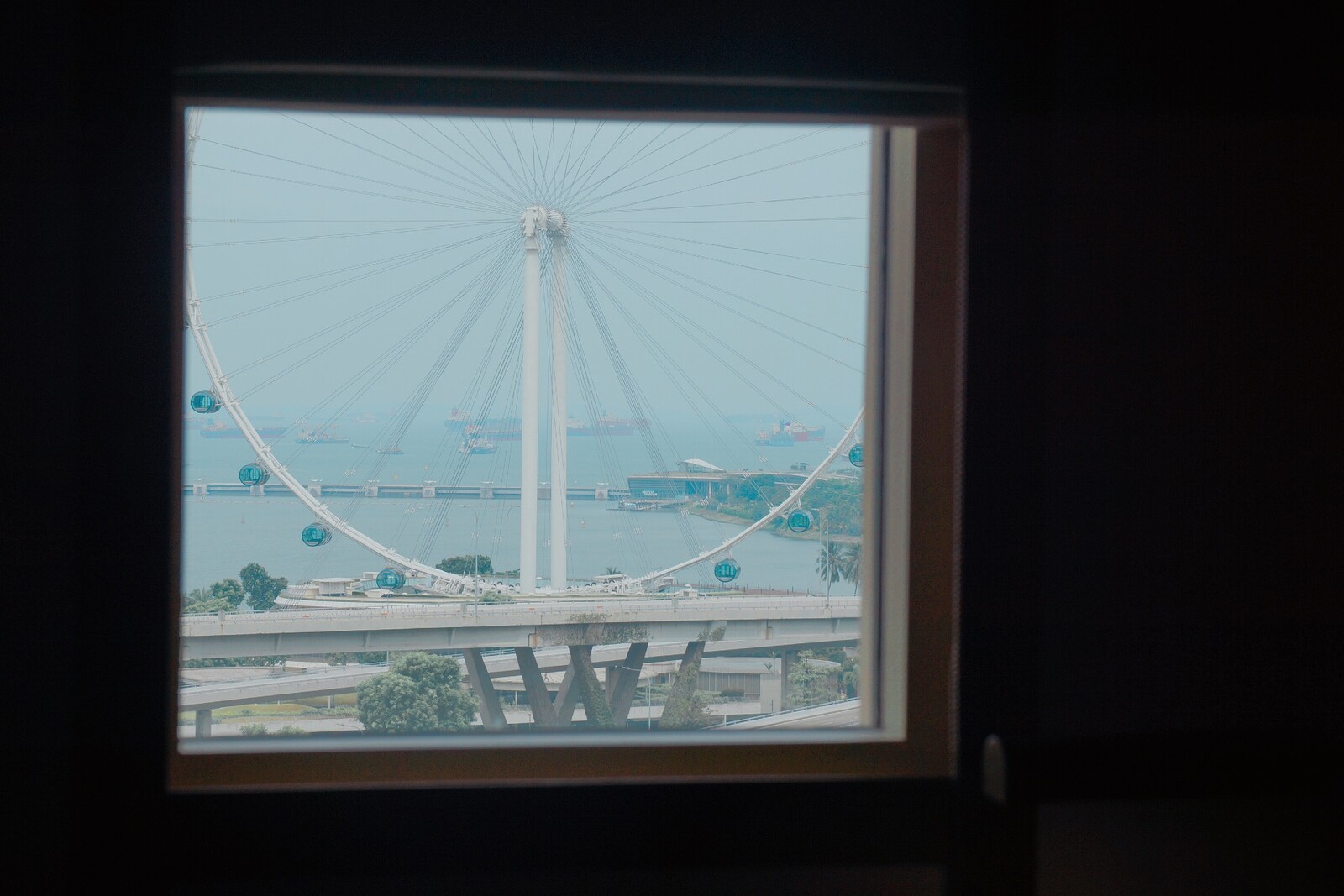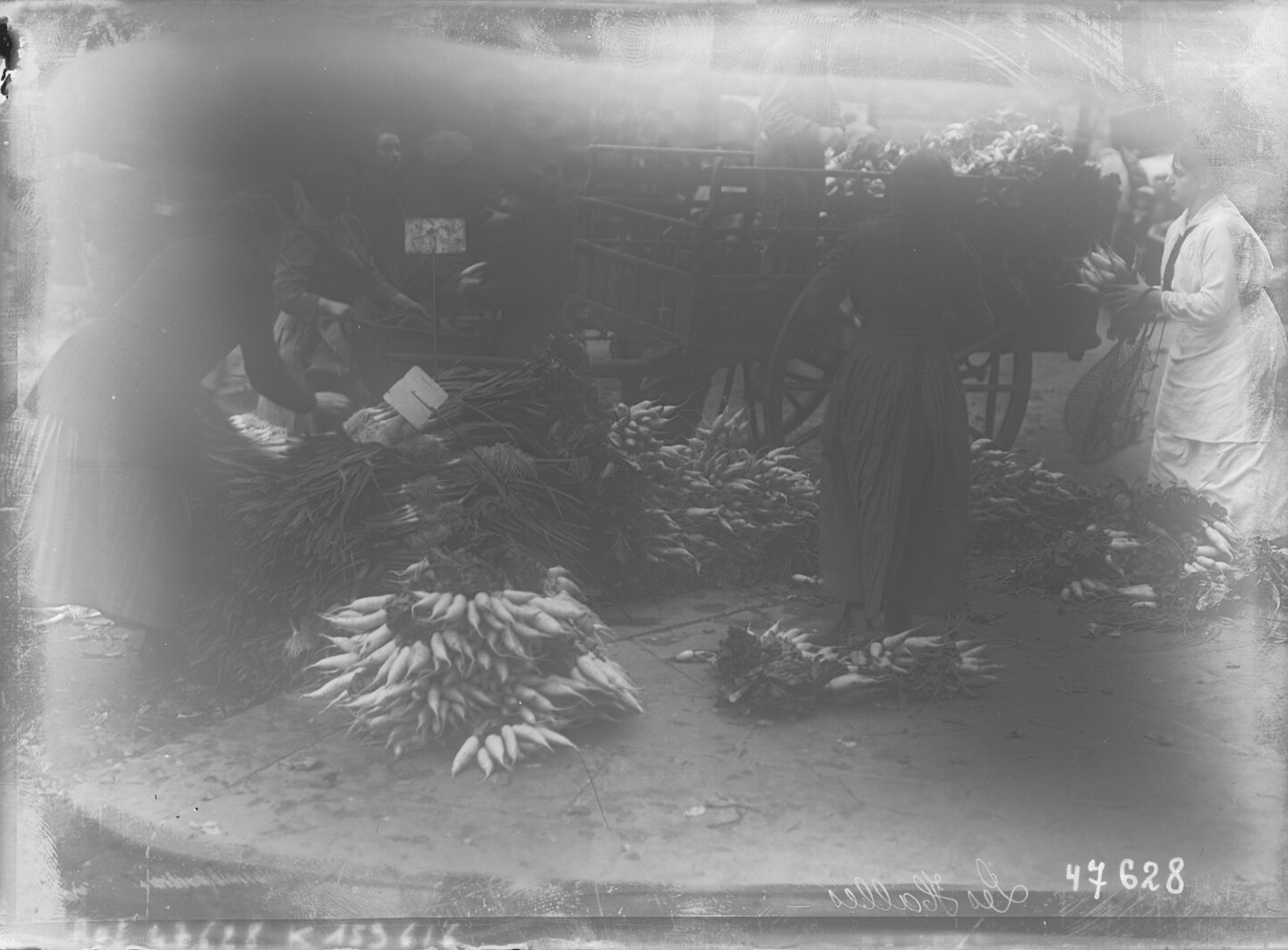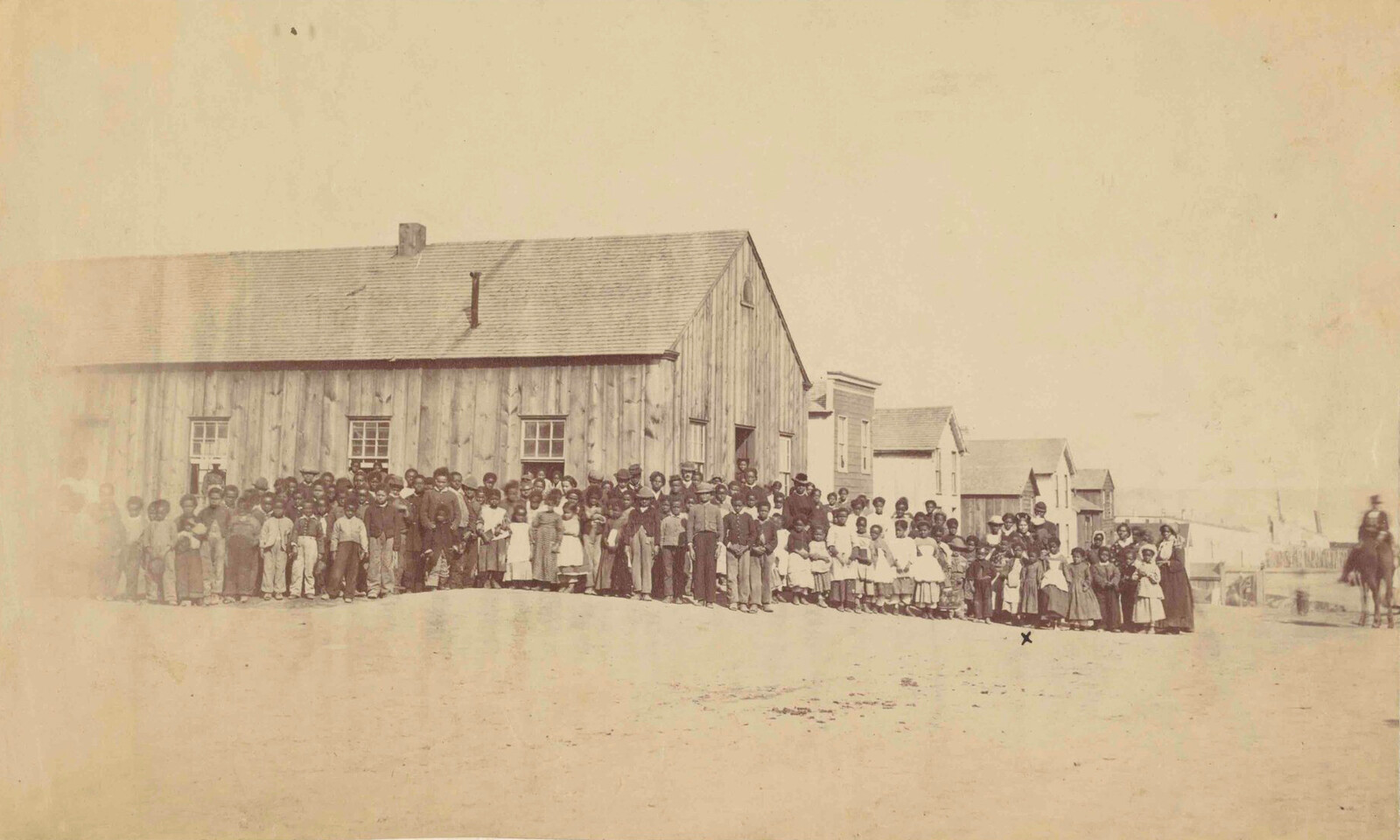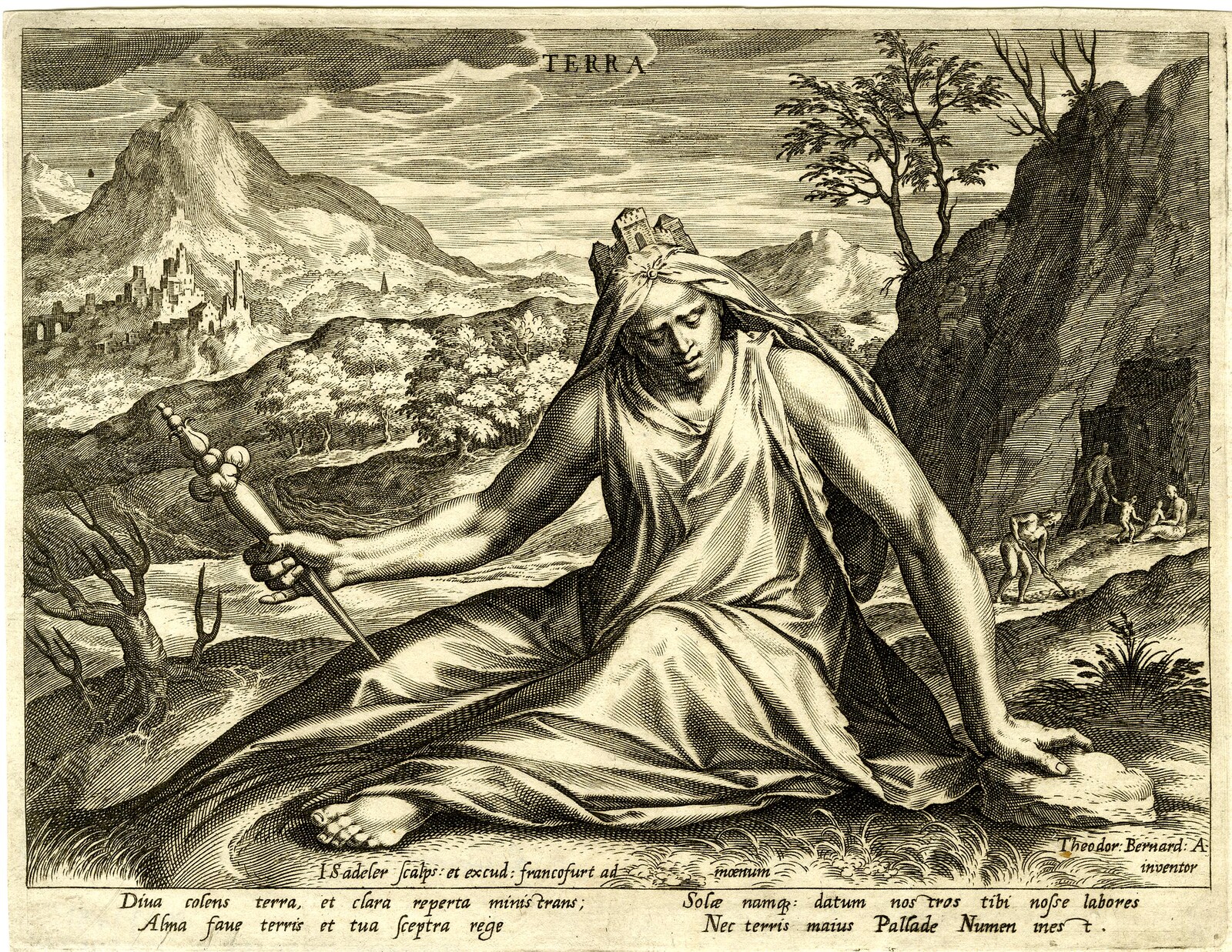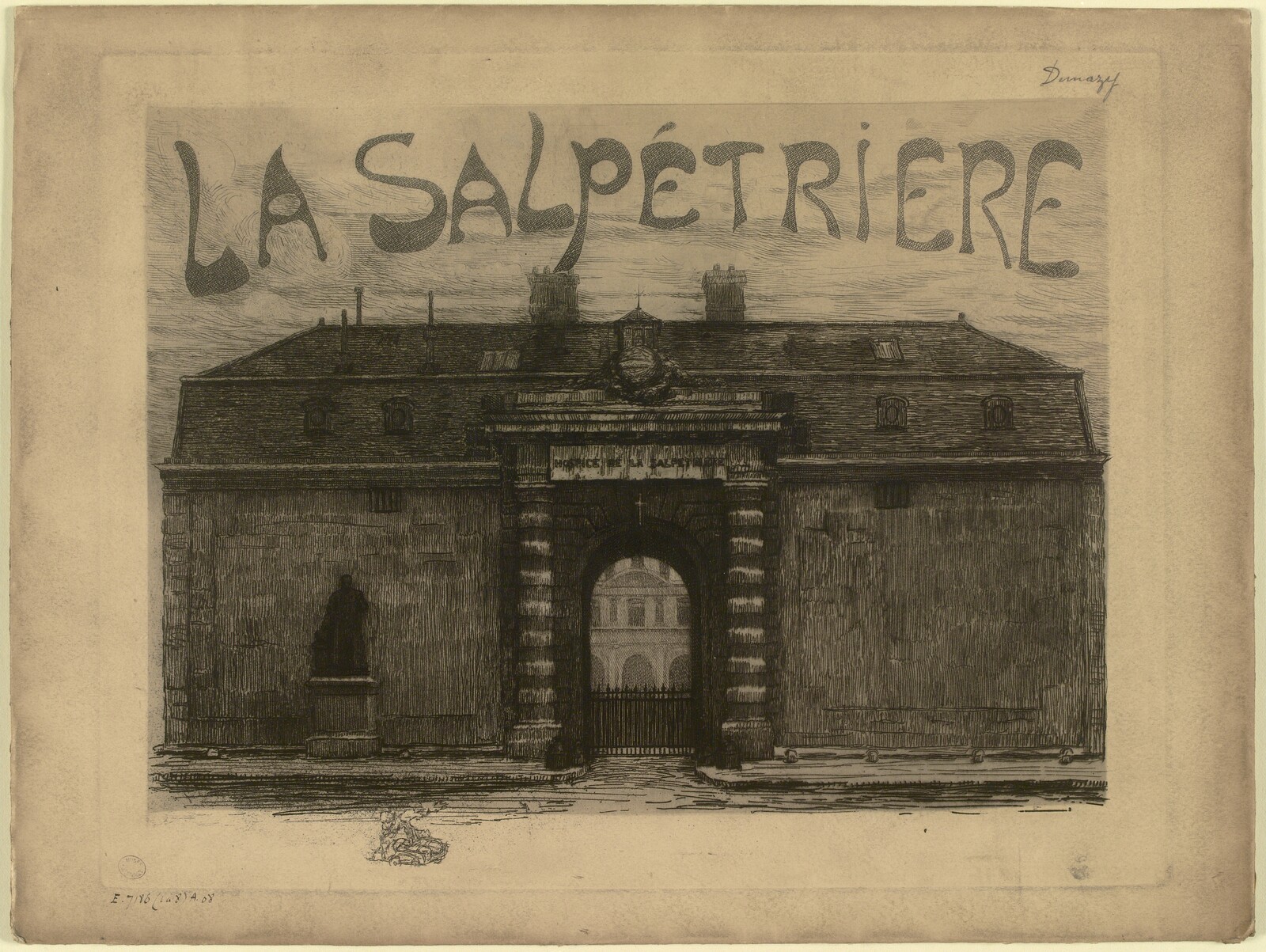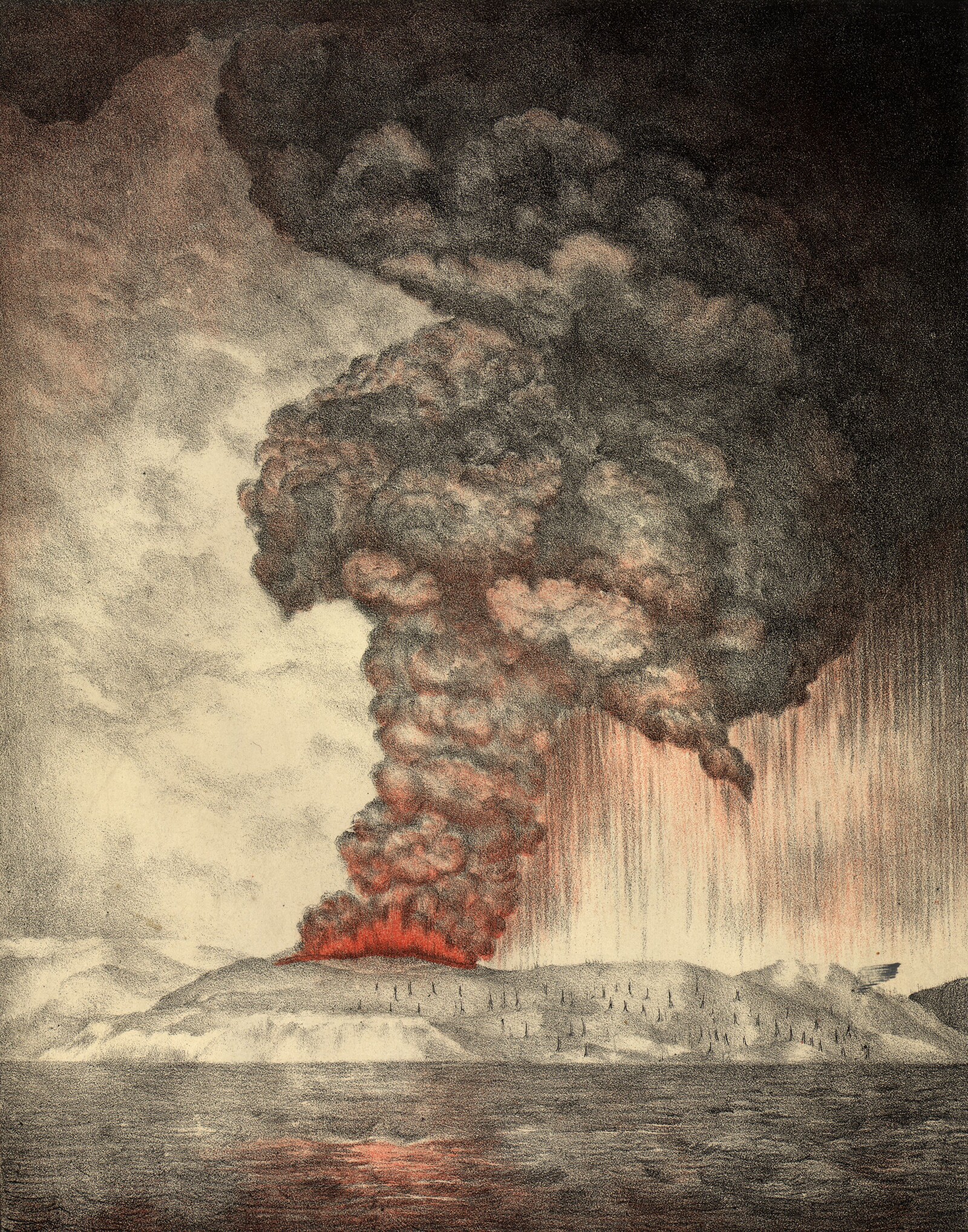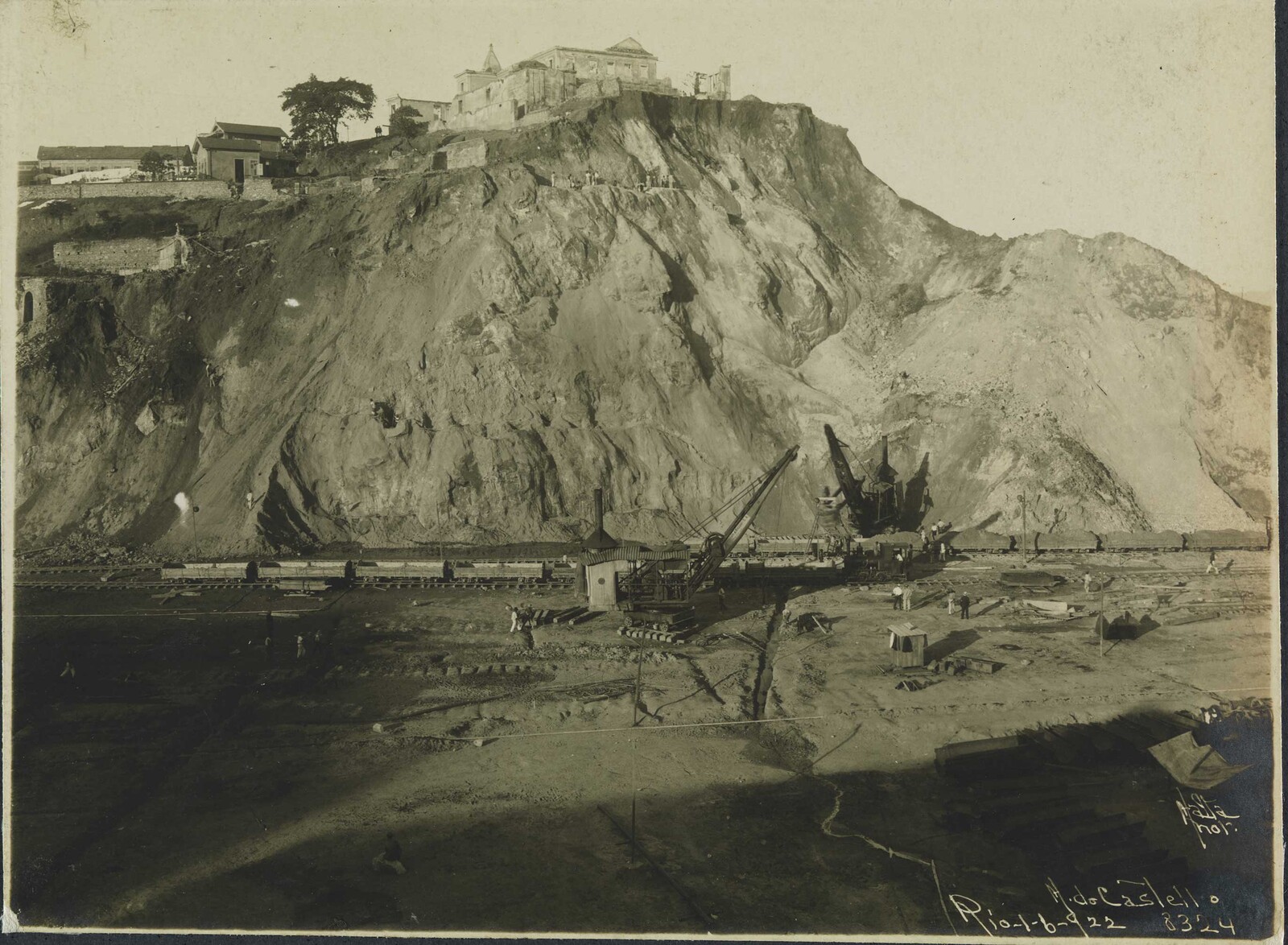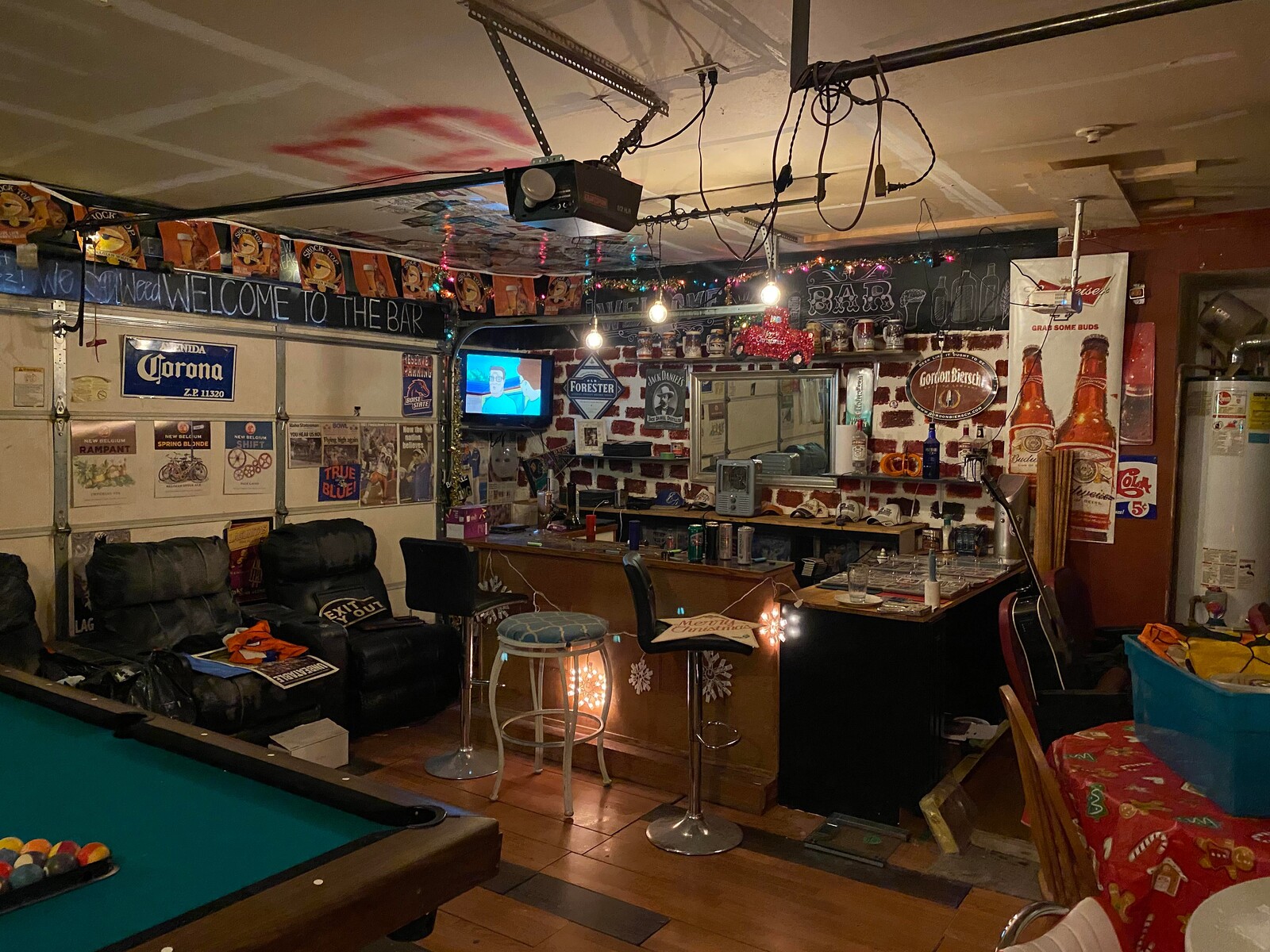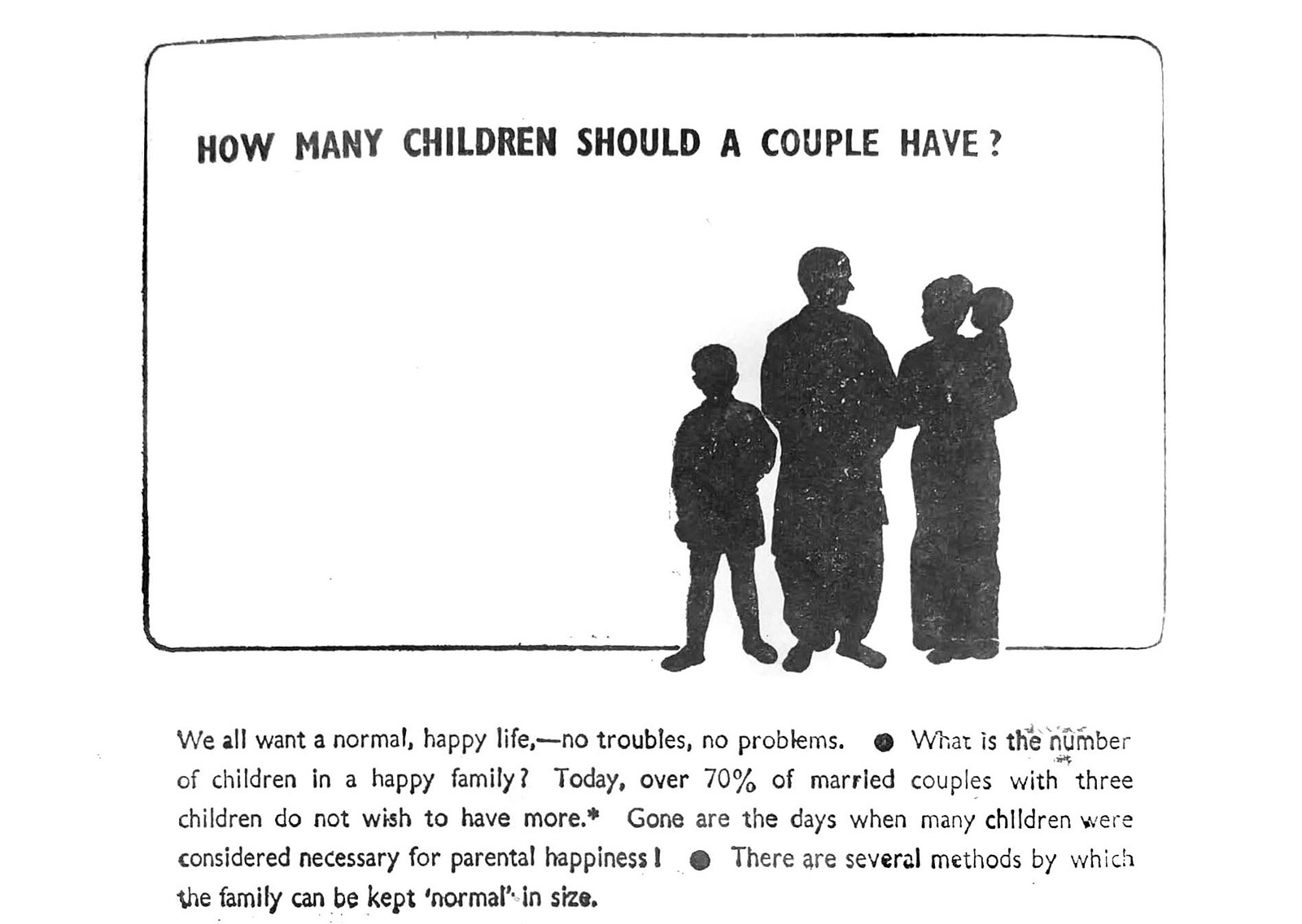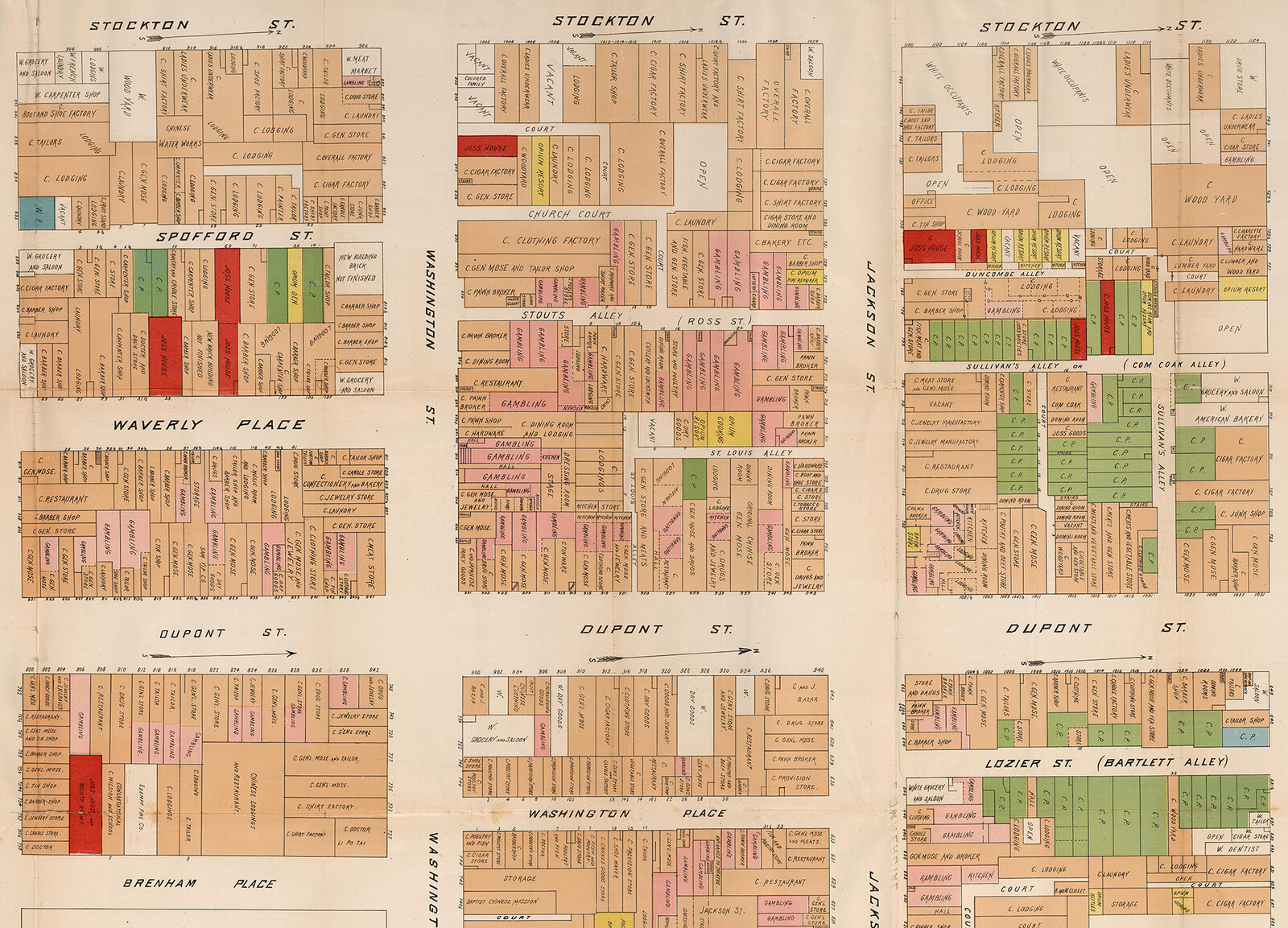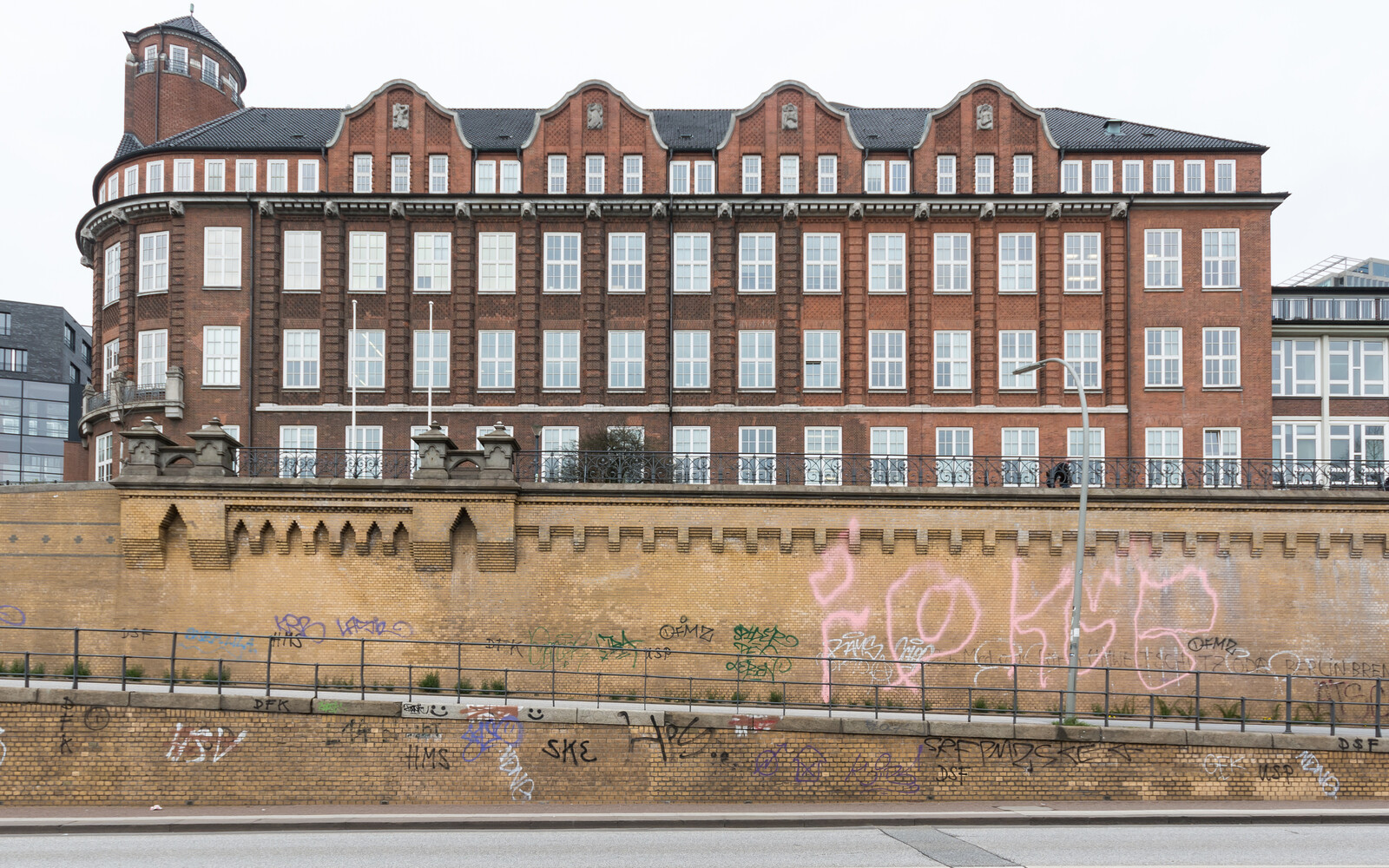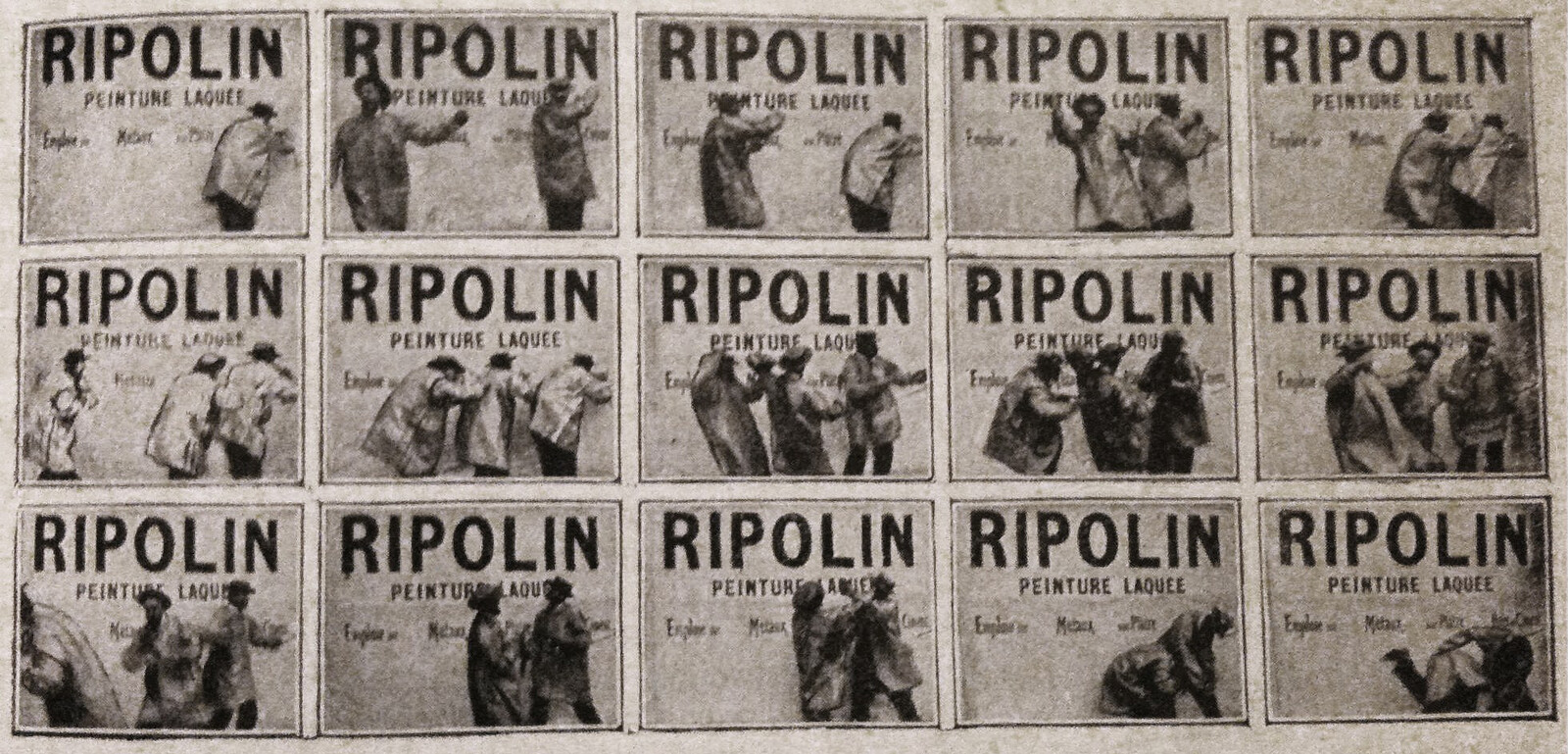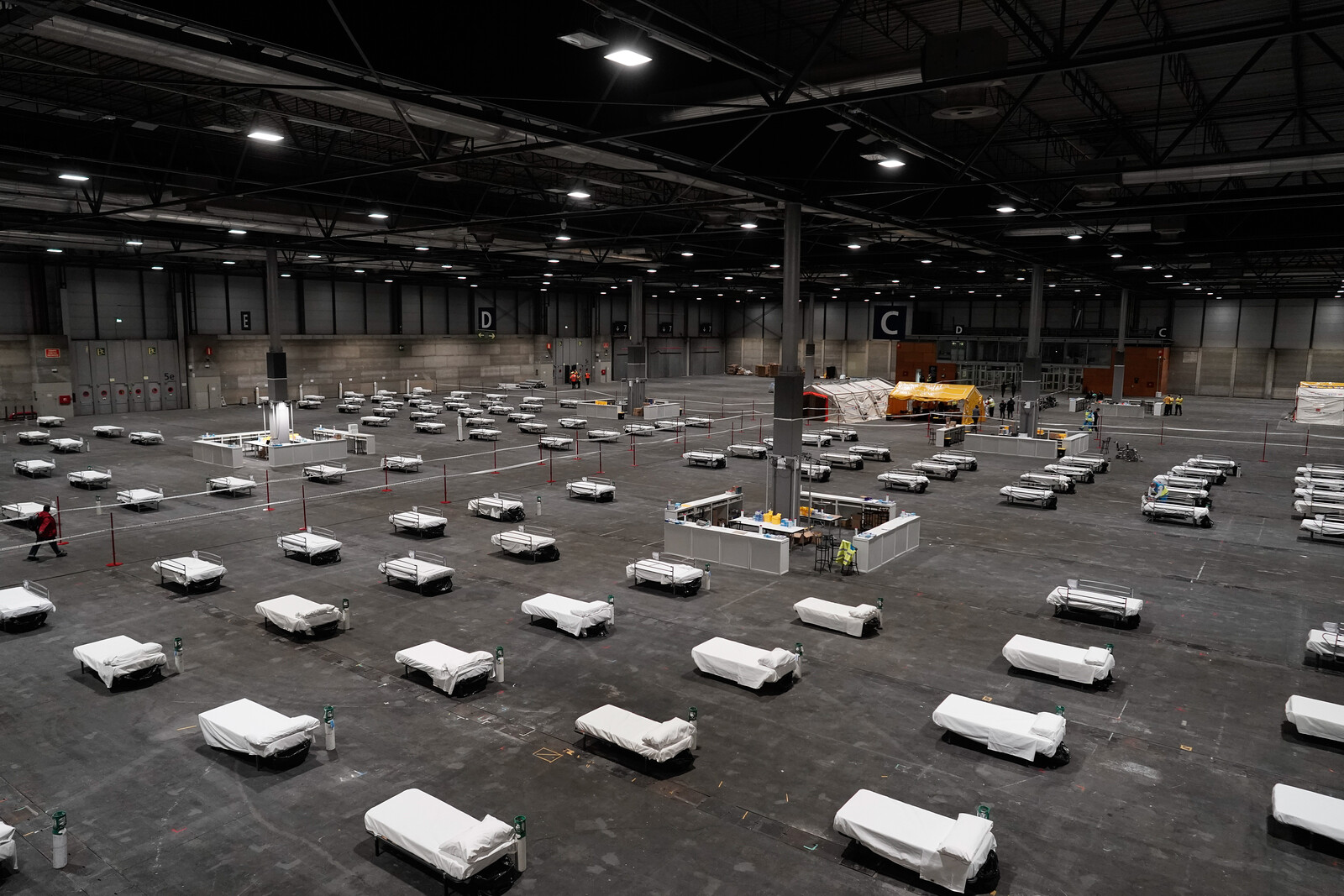We do not see the woman as inferior, but rather as having a different mission, a different value, than that of the man. Therefore we believed that the German woman, who more than any other in the world is a woman in the best sense of the word, should use her strength and abilities in other areas than the man… At the risk of sounding reactionary and outdated, let me say this clearly: The first, best, and most suitable place for the woman is in the family, and her most glorious duty is to give children to her people and nation, children who can continue the line of generations and who guarantee the immortality of the nation.
—Joseph Goebbels1
On March 18, 1933, just four days after his appointment and in his first public appearance as Reichsminister of Public Enlightenment and Propaganda, Joseph Goebbels spoke at the opening of the exhibition Die Frau in Familie, Haus und Beruf (The Woman in Family, Home, and Workplace). His deeply sinister statements on the position of women in the National Socialist party’s vision for society signaled the violently misogynistic rhetoric that was to be legally codified in the coming months, and to remain a pillar of Nazi ideology for the entirety of its time in power. “As long as a nation has such a proud and noble womanhood, it cannot perish,” Goebbels declared. “These women are the foundation of our race, of its blood, and of its future.”
In opening an exhibition devoted to women’s lifestyles and livelihood, the Nazis were initiating a series of policies that would ultimately limit women’s access to university education, restrict professional opportunities, and determine who could and could not have children. By naming “our race, our blood, and its future,” Goebbels underscored the central aims of the exhibition: a didactic display of femininity which centered around the woman’s reproductive potential. Nazi rhetoric famously heralded the connection between “Blut und Boden” (“blood and soil”) as rationale for its racist and nationalist foundations. Yet one notably anathematic form of the “blood” that Goebbels refers to is menses. Crucial to address, as Nazis sought to reverse falling birthrates, menstruation was featured prominently in the exhibition’s section on women’s health and wellness. The way in which the topic was discussed and depicted had profound implications for the role of women in Nazi society, an inchoate expression of the repressive policies to come.
A series of didactic posters used both quantitative diagrams and illustrations to describe the importance of proper menstrual hygiene, the imperatives of maintaining a “regular” menstrual cycle, and the significance of menstrual health for the development of a German Herrenrasse. While the exhibition writ large contained a wealth of information on Nazi conceptions of womanhood and femininity, its materials attending to menstruation in particular offer an opportunity to scrutinize engagements between the Nazi political apparatus and the members of the society it sought to perfect and control. The timing, content, and visual program of Die Frau reveals the complex nature of the ways in which these shifts were felt in German society.
Die Frau was instrumental in constructing the image of the “Aryan” woman. The violence that this construct inflicts, both rhetorically and directly, cannot be overstated.2 As Wilfried van der Will has written, the oppressive practices of representation particularly evinced in depictions of the human body followed a deliberate shift away from the more heterogeneous social structure of the Weimar era toward a broader ideology of control and a political grammar “based on the symbolism of hierarchical integration.”3 Nazi depictions of the female form attempted to restore women to a pre-industrial (and clearly fictitious) idea of German femininity, to an idyllic destiny corrupted by the onset of the discursive practices of industrial modernity.4 Yet in embarking on a project of ostensibly “idyllizing” the German female form, early Nazi propaganda paradoxically drew on the aesthetic logic of the avant-garde and the very heterogeneity of Weimar visual culture it was soon to renounce. Photomontage, collage, caricature, and cautious cubism were used to depict a conservative and accessible image of the woman, one that is solely organized around her childbearing and homemaking potential.
Exhibiting Femininity
Die Frau in Familie, Haus, und Beruf opened on March 18, 1933 at the Funkturm exhibition center in the Westend neighborhood of Berlin. Though short, the very site of the exhibition had a rich history of public attractions which sought to convey the promises and practices of a “modernizing” society. From the radio technology exhibits that inaugurated its opening in 1926 to a series of trade fairs promoting new and innovative German products, the site was inscribed in public consciousness as the venue par excellence for modern, future-oriented public programming. Convened as a joint effort of the city of Berlin, the Deutsches Hygiene-Museum in Dresden, and several Nazi-affiliated women’s organizations known as Frauenverbänden, Die Frau was initially conceived as a successor to an expo of the same name originally staged by the woman’s group Lyceum in 1912 at Berlin’s botanical garden.Katherine Rossy. “Politicizing Pronatalism: Exploring the Nazi Ideology of Women through the Lens of Visual Propaganda, 1933-1939,” Graduate History Review 3, no. 1 (2011): 58n48.] While the 1912 exhibition was praised for foregrounding women’s autonomy (thanks in large to the work of Gertrude Bäumer, a women’s rights activist and Lyceum member), the 1933 exhibition received acclaim for the centrality of motherhood as a driving force behind its design.
Bruno Gebhard, the newly appointed Scientific Director of the Berlin Trade Show Commission and Die Frau’s director, had trained as a doctor in Rostock and Leipzig before beginning a medical career in Dortmund. But it was a visit to the 1926 GeSoLei expo in Düsseldorf, the largest trade fair staged in the Weimar Republic, that convinced him to seek work in exhibition design. Between 1927 and 1932 Gebhard worked as a scientific assistant at the Deutsches Hygiene-Museum in Dresden, and his experiences at that institution—itself founded following the success of the 1911 Dresden Hygiene Exhibition—provided formative experience in tailoring medical knowledge for public consumption.5 The Deutsches Hygiene-Museum contributed significant materials to three subsections in Die Frau dedicated to women’s health—“The Woman as Wife and Mother,” “The Woman as Mother (the Child),” and “What Should the Woman Know About Food?”—covering topics such as livelihood, housekeeping, sexual wellness, reproductive health, common children’s diseases, other childrearing considerations, nutrition, and lifestyle. Most of the posters and physiological models were retained by the Deutsches Hygiene-Museum following the closure of the exhibition, but 1945 Allied bombing campaigns destroyed much of this collection. What survived, however, is a series of photographs which document individual objects from the women’s health subsections. While no comprehensive plan of the exhibition survived, its aesthetic program is still abundantly clear thanks to this documentation.
One poster included in “The Woman as Wife and Mother” depicts a woman’s head, photographed from behind. We cannot see the woman’s face, but the visual clues as to her mental state are collaged into a circle in the middle of her head. In what appears to represent a literal look into her skull, we see a photomontage which includes pots on a stove, children playing precariously close to the wheels of an automobile, a reclining woman who appears exhausted, and a wallet with only a few coins left in its folds. The resemblance of this poster to techniques of Dada photomontage is striking. John Heartfield’s Whoever reads bourgeois newspapers becomes blind and deaf: away with the stultifying bandages! (1932) not only uses a similar graphic language, but does so in order to make a shockingly similar argument about mental precarity in the face of modern life. Yet while Heartfield’s slightly earlier photomontage is an obvious affront on the stultifying potential of popular media, the poster from Die Frau suggests that it is a woman’s commitments as a mother and housewife that are all-consuming. Taken alongside other material from the exhibition, it effectively cautions against pursuing responsibilities outside of the home. Within a month of Die Frau’s exhibition’s opening, on April 7, 1933, the Nazi parliament passed the Law for the Restoration of the Professional Civil Service (Gesetz zur Wiederherstellung des Berufsbeamtentums), which allowed party officials to cull anyone perceived as “politically threatening” from public employment and led to dozens of women being fired who had held jobs in the public sector for their leftist or feminist views.
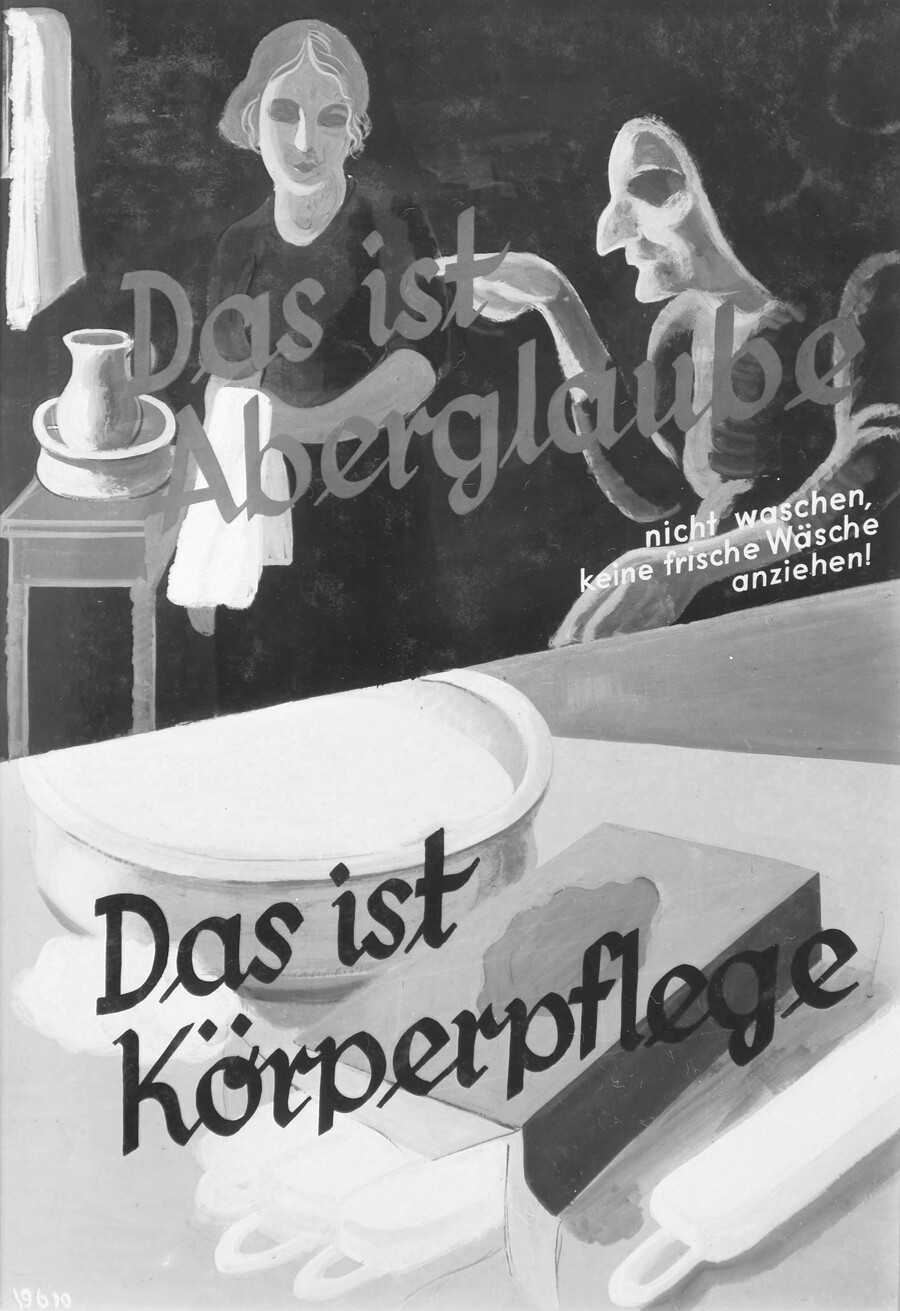

“Das ist Aberglaube … Das ist Körperpflege” (“That is superstition … That is bodily care”), 1933. Source: Deutsches Hygiene-Museum Dresden, Germany, DHMD 2001/246.13.
The Menstrual Pad
Two posters from “The Woman as Mother (The Child)” each include didactic messages about how a woman should conduct herself during menstruation. The first poster is a divided image, an illustration of an encounter between a young woman and an old woman contrasted with an illustration of modern sanitary products. At top, the young woman holds a towel and appears to hesitantly glance at a jug of water and a washbasin as the veiled older woman, whose profile is a racialized caricature, gestures toward these objects. The figures are simple illustrations that show a clear contrast between the young, which is represented as healthy, beautiful, and pure, and the old, which is as dark, unattractive, and unclean. At the bottom, a box of sanitary pads sits next to a basin of water. The box is open and several products are visible. Superimposed over the figures is text which over the figures reads “Das ist Aberglaube / nicht waschen, keine frische Wäsche anziehen!” (“That is superstition / no washing, no fresh undergarments!”), and over the sanitary products reads “Das ist Körperpflege” (“That is bodily care”). The message of the poster is obvious: the modern woman should reject outdated folk knowledge in favor of contemporary hygiene. What is striking, however, is not the contrast between light and dark in the two halves, but the surreal whiteness of the menstrual pad; an object so commonly associated with abjection, and a distinctly feminine abjection at that.
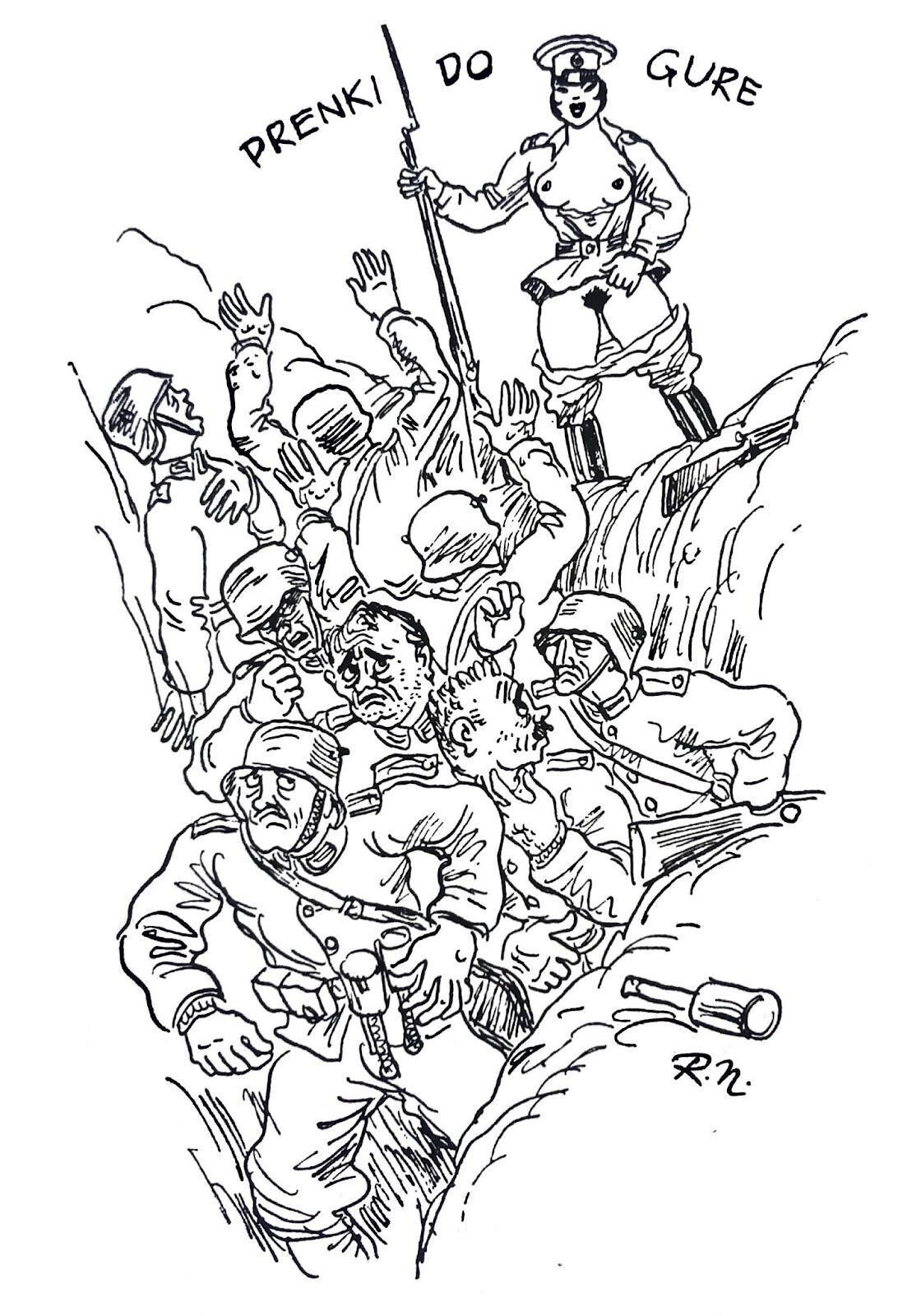

Polish Illustration from c. 1920s. Source: Klaus Theweleit, Male Fantasies Volume 1: Floods, Bodies, History, trans Stephen Conway (Minneapolis: University of Minnesota Press, 1987), 200.
In his seminal 1977 psychoanalytic study of the rise of German Fascism, Klaus Theweleit advances a number of theses on the repression of the “soldier male,” his term for the violently misogynistic Freikorps member that constitutes the central object of the two-volume book. Theweleit opens his project by addressing the relationship between these soldier males and women as depicted in literature written by Freikorpsmen: mother and wives, enemies in the form of communist fighters and nurses, as well as the abstracted conflation of both archetypes. Where the mother and wife are rendered “white”—angelic and benevolent, but also vacuous, empty, void of emotion—the “red woman” is a violent deluge: she is sexualized, wild, unclean, unrestrained, and often depicted as masculine. The “red woman” will attack the solder male with sweat and spittle flying off of her unwashed body; she will seduce him only to drown him in blood—his own blood, or that of her menses. Theweleit’s analysis allows him to advance the thesis that among the solder male’s greatest phobia was the “flood”: the unchecked surge of an advancing army, of bodily fluid and emotion. He summarizes this notion at the beginning of his study’s second volume: “The most urgent task [of the soldier male] is to pursue, to dam in, and to subdue any force that threatens to transform him back into the horribly disorganized jumble of flesh, hair, skin, bones, intestines, and feelings that calls itself human—the human being of old.”6 The Die Frau sanitary products poster demonstrates how the Nazi party sought to address the “flood” expelled from each woman’s body, from her terrifying interior, every month. The only way sanitary hygiene could be depicted was through imagery which emphasized the order and organization of a given product, which was in turn rendered banal and nearly stripped of its relationship with abjection.
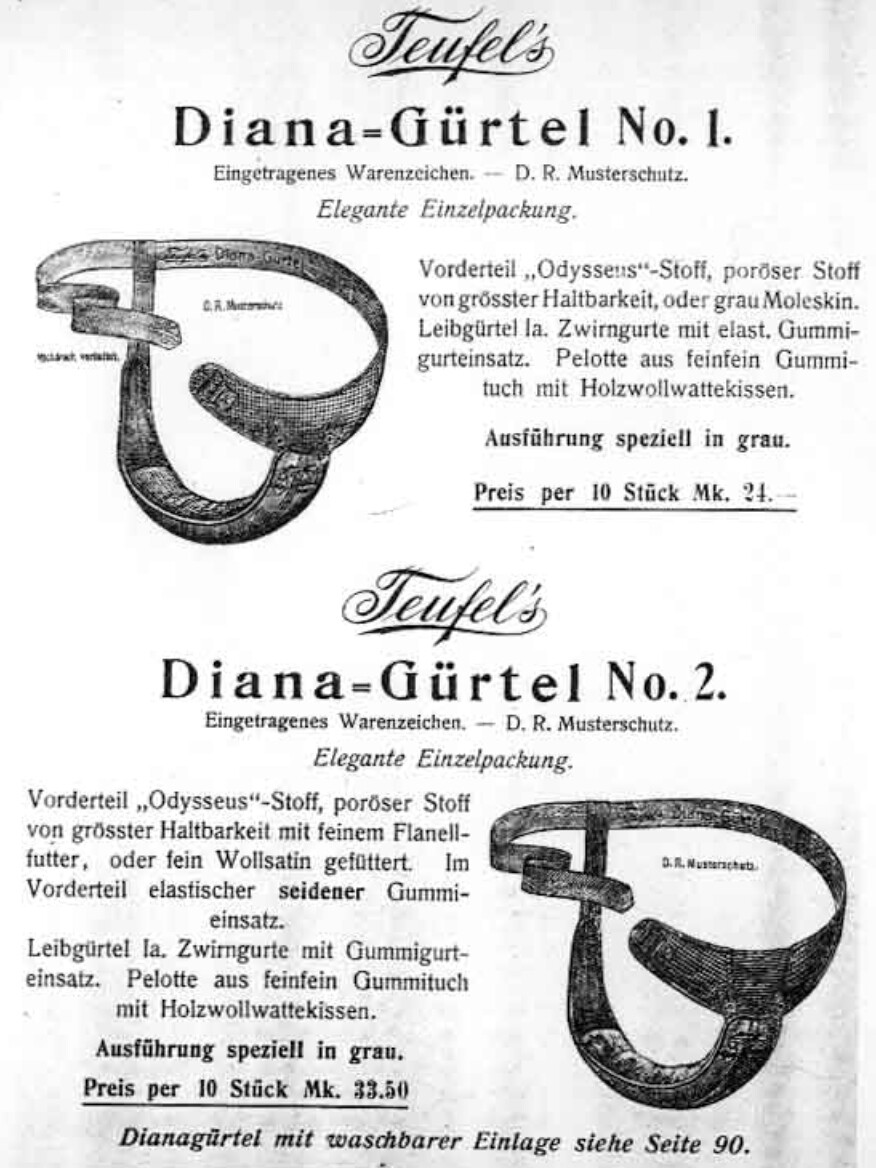

Teufel’s brand “Diana-Gürtel,” early twentieth century (probably around 1900). Source: The Museum of Menstruation and Menstrual Health.
The sanitary pads depicted at the bottom of the poster are an unfamiliar design today. Self-adhesives were not used in the production of women’s sanitary products until 1972. Instead, beginning in the late nineteenth century, women wore objects with hoops to be attached to belts and worn under clothing during menstruation. In 1926—the same year that the Funkturm exhibition grounds opened to the public—the company Camelia brought the very first disposable menstrual pad to market. Founded by the Jewish businessman Oskar Rosenfelder, the Camelia brand’s previous washable pads were marketed toward women with a logic of discretion: the products were named for Dumas’ play La Dame aux Camélias, in which a prostitute wears a white flower when she can receive clients and a red flower when she is menstruating. Each Camilia box came with a removable card, which a woman could pass off to a shop clerk rather than voice her request directly.7 The status of menstrual products in 1930s Germany, then, included secrecy, veiled allusions to sexuality, and the nature of “independence” and “mobility” still central to much sanitary product marketing today.
Women’s menstrual care has always inscribed a logic of control on the female body. This also has a semantic dimension: in German, several words refer to menstruation, including “die Periode,” “die Menstruation,” and “die Regel.” While the first two of these words have obvious English cognates, “die Regel” does not, at least not commonly. Alternatively translated as “rule,” “law,” or “regulation,” the term implies what is clearly at play in the visual rhetoric of menstrual garments: that menstruation should by its very nature adhere to a rule, a law, a regulation. The emphasis on order and regimentation in the poster’s depiction of menstrual pads, alongside its overt rejection of folk knowledge and tradition, suggests a distinctly modern approach to menstrual hygiene. Here the modern menstrual pad can be read as a symbol for the Nazi formulation of the “normalized” woman: ordered and regular, white and sanitized, a corrective to the unpalatable figure of the aging, unhygienic symbol of an abject and infertile past.
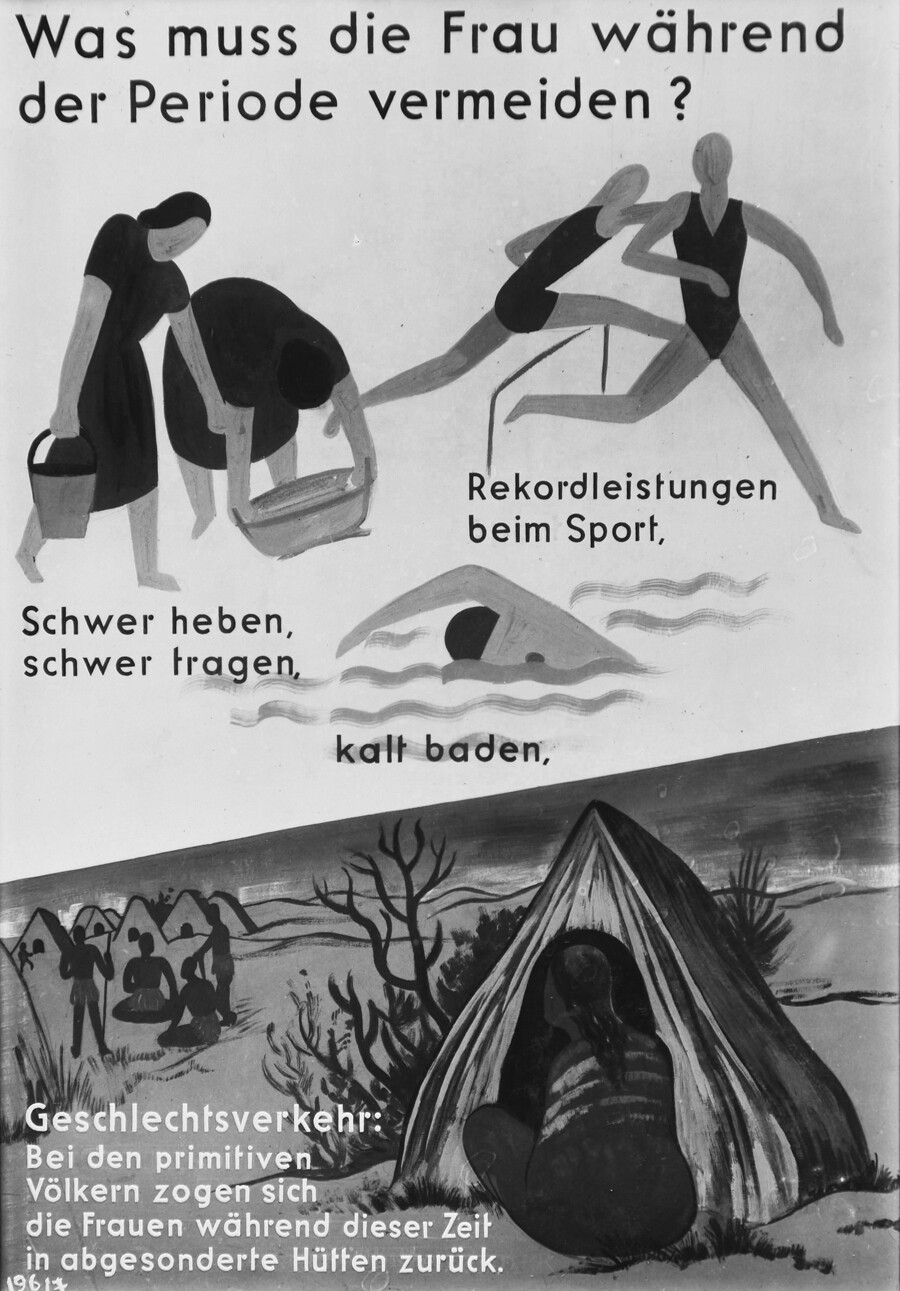

“Was muss die Frau während der Periode vermeiden?” (“What must the woman avoid when on the period?”), 1933. Source: Deutsches Hygiene-Museum Dresden, Germany, DHMD 2001/246.12.
The Menstruating Woman
The second poster, which also contains two images, insists on what women should avoid during menstruation. At top, heralded by the title “Was muss die Frau während der Periode vermeiden?” (“What must the woman avoid when on the period?”), abstracted female figures complete a series of activities: they bend over, lifting baskets and buckets; dressed in sports leotards, they hurdle; one figure is swimming. Messages correspond to each action: “Schwer heben, schwer tragen” (“Heavy lifting, heavy carrying”), “Rekordleistungen beim sport” (“Record-setting sports”), “kalt baden” (“cold bathing”). At the bottom of the poster is a more detailed illustration. In the foreground is a crude dwelling, where the silhouette of a crouching female is just discernible. In the middle ground, another series of dwellings and a group of figures (presumably male) sit cross-legged on the ground. In the background is a landscape, with rolling hills and sparse suggestions of vegetation. The text which accompanies this image reads “Geschlechtsverkehr: Bei dem primitiven Völkern zogen sich die Frauen während dieser Zeit in abgesonderte Hütten zurück.” (“Sexual intercourse: among primitive people, women were sent to isolated huts during this time”).
An operation similar to that of the first poster takes place here. The “primitive community” shown in the bottom half of the poster references alterity in emphasizing the contemporary conditions of Nazi society. The text included in the image makes no argument: the statement that women were “sent” or “sent back” (zurück) to isolated huts is not a commentary on antiquated practices so much as it is a display of difference, of primeval logic which might bear importance for the present. At top, the menstruating female figure is rendered faceless, nearly formless; performing tasks like lifting and hurdling she is not a subject but an object, a lifeless automaton.
In his analysis of Nazi labor discourses, Anson Rabinbach describes the Amt Schönheit der Arbeit or “Bureau of Beauty of Labor,” founded on November 27, 1933.8 The Bureau’s projects included incentivizing the beautification of factories and other industrial spaces, the dissemination of propaganda concerning “ideal workers,” and the production of models for everything from workrooms to kitchenware and furniture. While the Bureau sought to develop a “plant community” foregrounding anti-liberal ideals of work and masculinity, it also inherently drew on a “social aesthetic” which relied on prior discourses of rationalization and industrial modernization more commonly associated with leftist discourses on work and labor. In the context of the factory, the Nazi fantasy of a utopian space of labor was one where, as Nazi engineer Karl Arnhold put it, “the tempo of the machine [should] be brought into harmony with the rhythm of the blood.”9 The same logic undergirding Arnhold’s impression of the laborer as automaton is at play in the poster depicting menstruating bodies. What is visible in the poster is both a mechanization of the woman’s body and a fetishistic recapitulation of a natural process. Taken in the broader context of Nazi theories of figurative representation, this dualism would only become increasingly prevalent: the female form is rendered at once a machine and as something natural and unknowable. She is both the idealized industrialization that the Nazis will bring to Germany and mother earth; both revered and deeply sexualized just as she is exploited and appropriated.10
There are uncanny similarities between the figures in motion and the “primitive hut” rendered below. The shape of each woman’s figure—in the peak of the elbow of the woman swimming, the spread legs of the hurdlers, and the bent back and extended arms of the carriers—mirrors the architectural form of the hut. These figures, then, instill this pseudo-historicist logic in another way: they literally embody the space of abjection, the hut for menstruation. Their form reflects a primitive architecture, a distinct challenge to industrial and urban modernity. Here, perhaps, the construct of “blood and soil,” the Nazi romanticization of a primordial, rural, and agrarian German identity, is compounded with the menstrual blood which informs this split scene: the harmony of the machine, be it in the factory or embodied in the machinic figures, is regimented by the repetitive nature of menstruation. There is no blood and soil, no advancing Nazi tide, without the blood of menses.
Regel-ated Representation
These posters were two objects in a much larger exhibition meant to display new conventions of femininity and womanhood. Yet “new” is the operative term. The “novelty” of women in Nazi society, understood in most readings as a repressive novelty, did not begin with the burning of the Reichstag. Such social transitions are embedded in imagery long before violent rhetoric becomes visible in direct policy making. Menstruation fit uncomfortably into the conventions of National Socialist ideology, and the discomfort it instilled staged a figurative representation and visual field that was inflected to support National Socialism but remains dominant today.
Violent policies continue to villainize women who do not menstruate: transwomen cannot exist in contemporary society without seeing their bodies rendered political, while those cis women who cannot or do not menstruate still face stigma and rejection in a society still largely unable to separate the notion of womanhood from the notion of motherhood. The way society sees women is always already historically and politically contingent: to the fascist male imaginary, as to many conservative commentators today, menstruation evokes a fear of the abject—but the lack of menstruation is an even more fearful condition. In Die Frau, where women were represented with both the imperative to procreate and the uncomfortable acknowledgement of female sexuality and subjectivity, artistic forms which predate the neo-classical realism celebrated by Nazi cultural ideologues drew on the aesthetic logic of movements once considered “radical.” We must continue to pay careful attention to the ways in which menstruation is represented, to the embedded logics of instruction, normalization, and regulation in such imagery. For just as Die Frau’s menstruation posters convey the complex ideology of early Nazi-era German society and intimate the murderous violence to come, we might find paradoxes which open up fraught dimensions of contemporary society’s understanding and treatment of menstruation.
Joseph Goebbels, “German Women,” speech by delivered March 18, 1933, trans. Randall Bytwerk (German Propaganda Archive at Calvin University), ➝.
Here my lack of consideration for Nazi perspectives on “non-Aryan” women should not be taken to mean that those formulations were any less complex or convoluted. Significant scholarship by by Renate Bridenthal, Myrna Goldenburg, and Zoë Waxman has examined femininity among communities persecuted by the Nazis. See: Renate Bridenthal, Atina Grossman, and Marion Kaplan, eds., When Biology became Destiny: Women in Weimar and Nazi Germany (New York: Monthly Review Press, 1984); Myrna Goldernberg. Before All is Lost: Women’s Voices from the Holocaust (Toronto: The Azrieli Foundation, 2014); and Zoë Waxman, Women in the Holocaust: A Feminist History (Oxford: Oxford University Press, 2017). Some scholarship on the role of menstruation among concentration camp detainees has also been produced, which draws heavily on oral histories and ethnographic work compiled by the United States Holocaust Memorial Museum. Emily A. Wood. “Tracing the Destruction of Women’s Bodies: Survivor Testimony of Menstruation in the Holocaust,” MA dissertation (University of New Brunswick, 2019).
Wilfried van der Will, “The Body and the Body Politic as Symptom and Metaphor in the Transition of German Culture to National Socialism.” In: The Nazification of Art: Art, Design, Music, Architecture, and Film in the Third Reich, eds. Brandon Taylor and Wilfried van der Will (Winchester: The Winchester Press, 1990), 14.
I say discursive here intentionally; it is very common in Nazi rhetoric that “industrialization” is made into some sort of vague boogeyman to which pretty much any social ill can be attributed, and most frequent as a dogwhistle for communism, which was characterized by fascists as anti-humanist. For more see Jill Stephenson, Women in Nazi Germany (Oxfordshire: Routledge, 2001), 12.
Bruno Gebhard. “The Health Museum.” Journal of Health Education 6 (1948): 133
Klaus Theweleit, Male Fantasies (Minneapolis: University of Minnesota Press, 1987), 2:xviii.
Juliane Sander. “Camelia, oder der Beginn der ‘Modernen’ Monatshygiene?” Fränkisches Freilandmuseum Bad Windsheim (January 1, 2022), ➝.
Anson Rabinbach. The Human Motor: Energy, Fatigue, and the Origins of Modernity (Berkeley: University of California Press, 1992), 286.
Ibid., 287.
This is an argument put forth in slightly different ways by several different scholars. Annie Richardson’s discussion of Nazi artworks and feminity, for example, reframes this duality. Citing the art historian Berthold Hinz, Richardson notes that one of the most critical dimensions of the representation of women in National Socialist visual culture was that of the potential for “distraction”—the ability of the image of the woman to serve as allegory for the war, promise of the aforementioned “return” to an idealized German society, and (most provocative) the attempt to directly “manipulate” the male’s sexuality by centering imagery of the female form. Annie Richardson, “The Nazification of Women in Art.” In: The Nazification of Art, 54.
Sick Architecture is a collaboration between Beatriz Colomina, e-flux Architecture, CIVA Brussels, and the Princeton University Ph.D. Program in the History and Theory of Architecture, with the support of the Rapid Response David A. Gardner ’69 Magic Grant from the Humanities Council and the Program in Media and Modernity at Princeton University.
